Java is an object-oriented programming language that is platform independent. It was developed by Sun Microsystems, now owned by Oracle. Java code is compiled into bytecode that runs on a Java Virtual Machine (JVM), allowing it to run on any device that supports a JVM. Java supports features like inheritance, polymorphism, and encapsulation. It is widely used for client-side applications like applets and server-side applications like servlets and Java Server Pages (JSP). The main Java editions are Java SE for desktop applications, Java EE for enterprise applications, and Java ME for mobile applications.
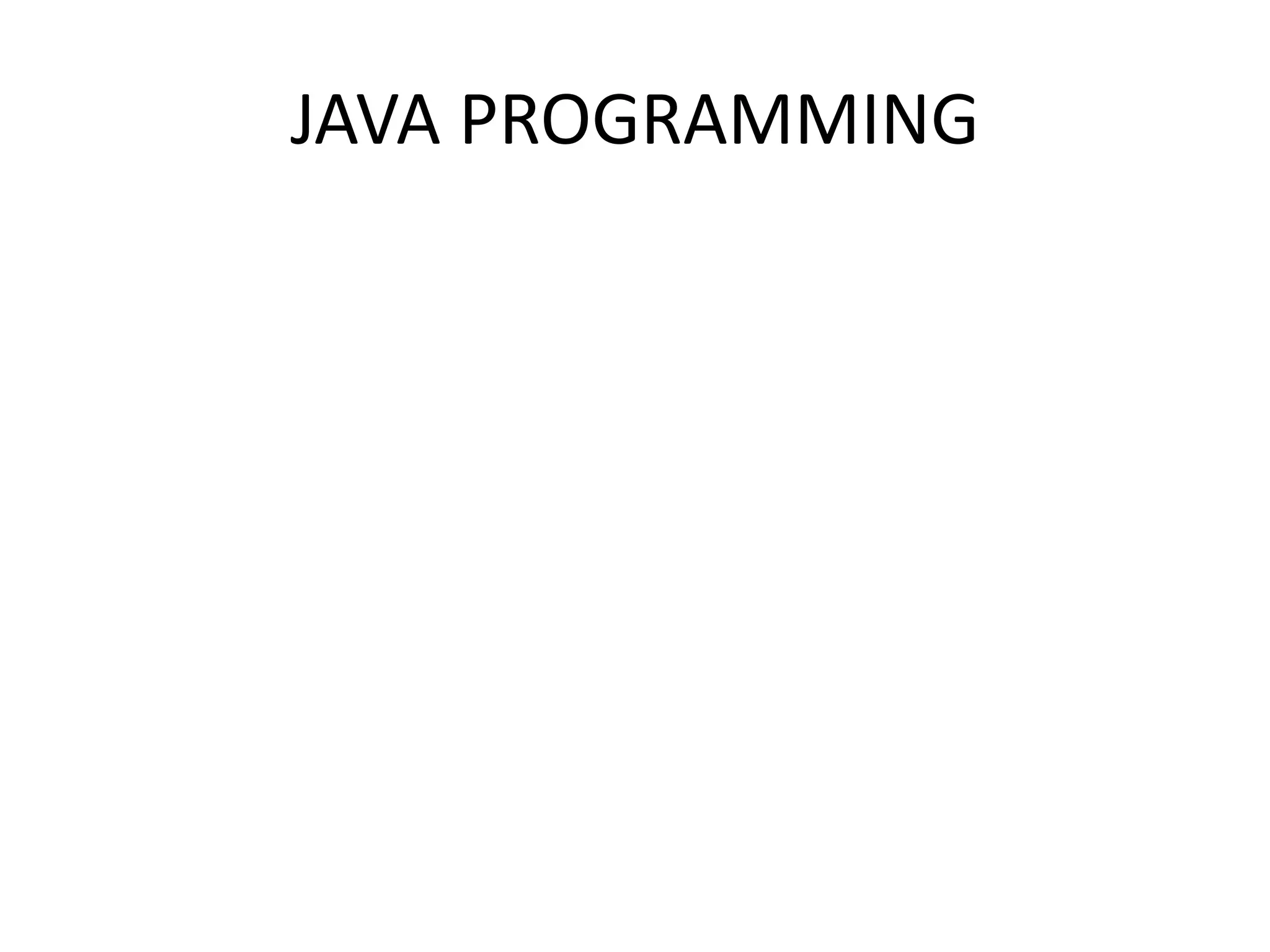
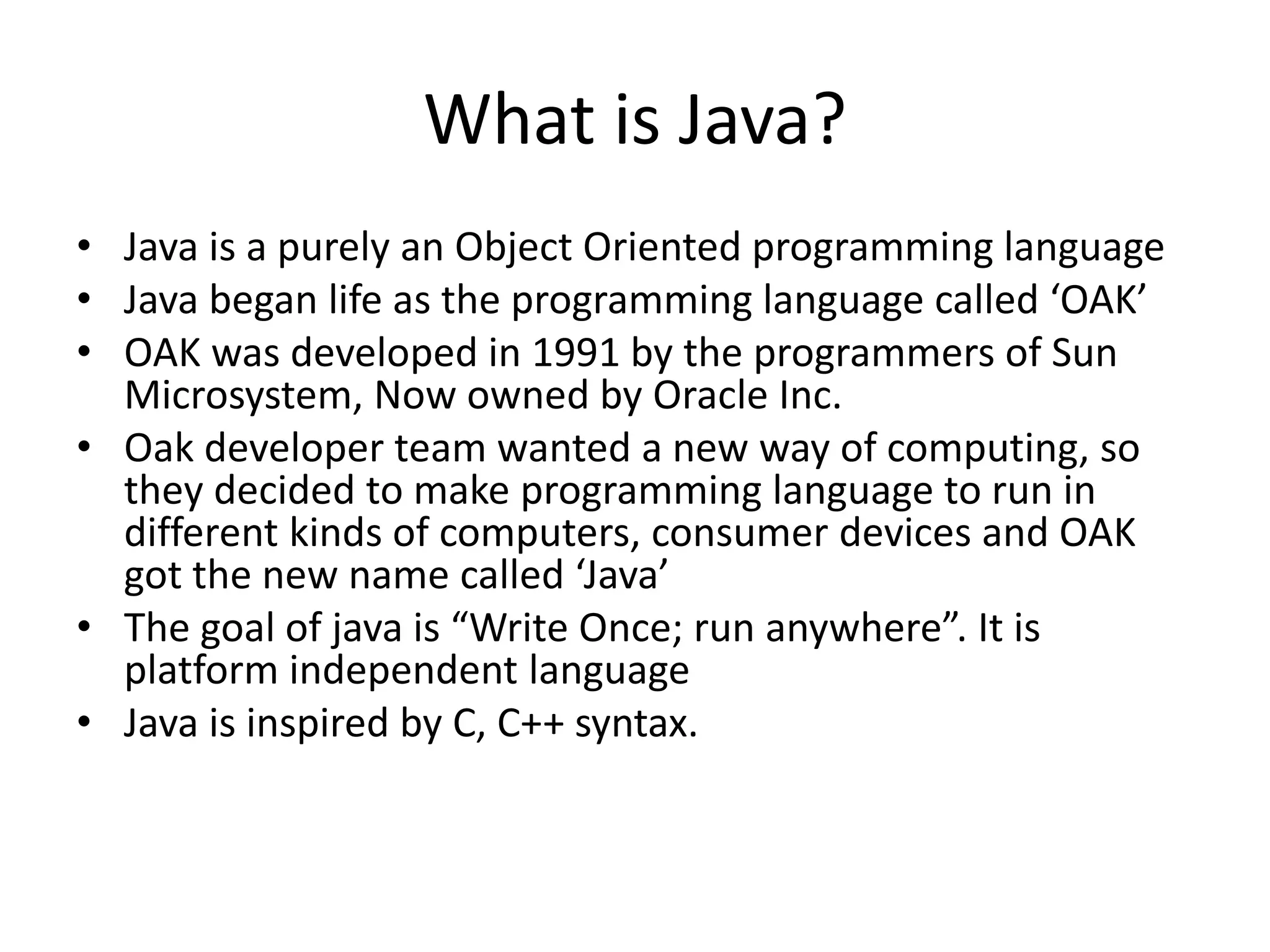
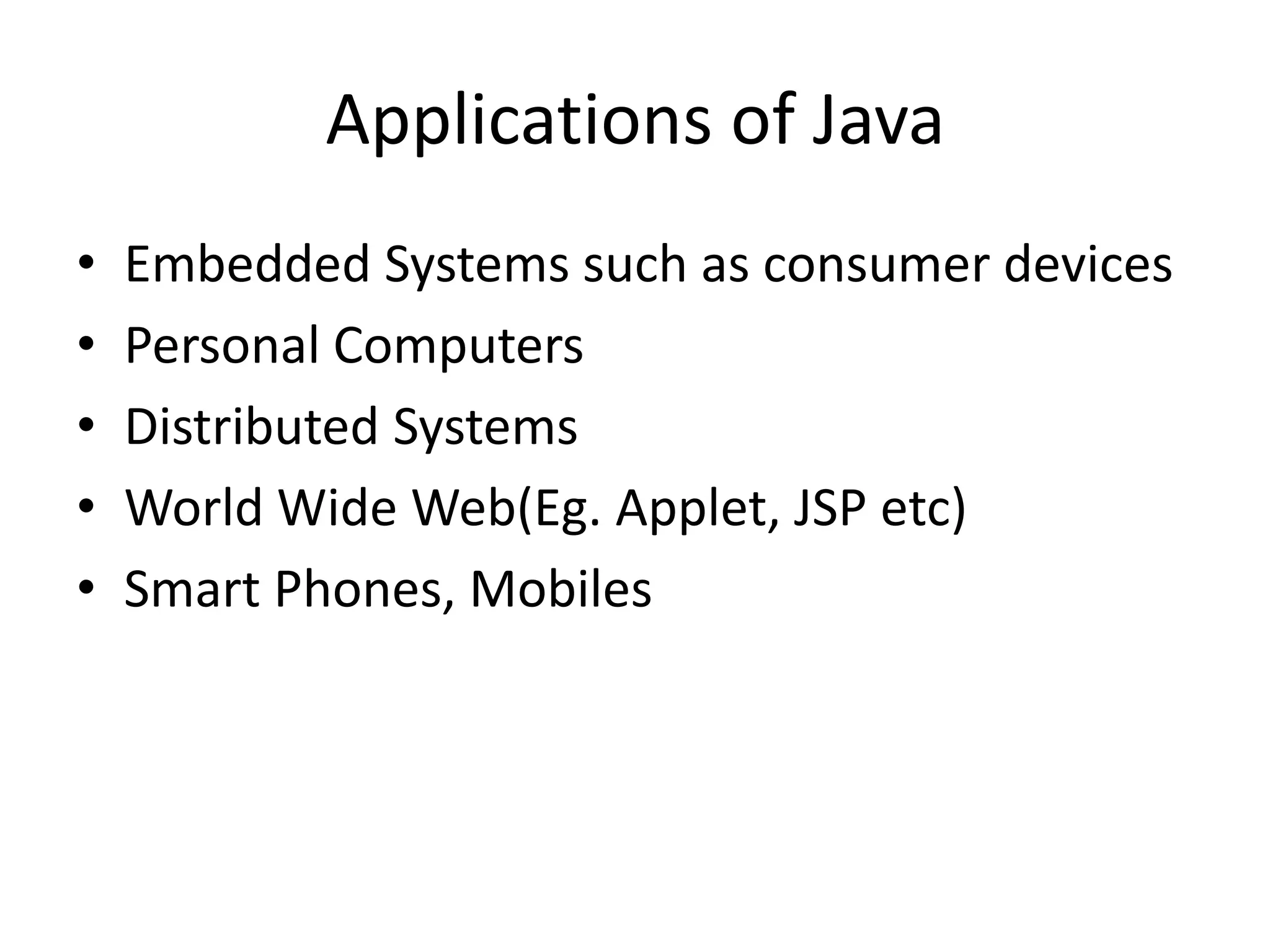
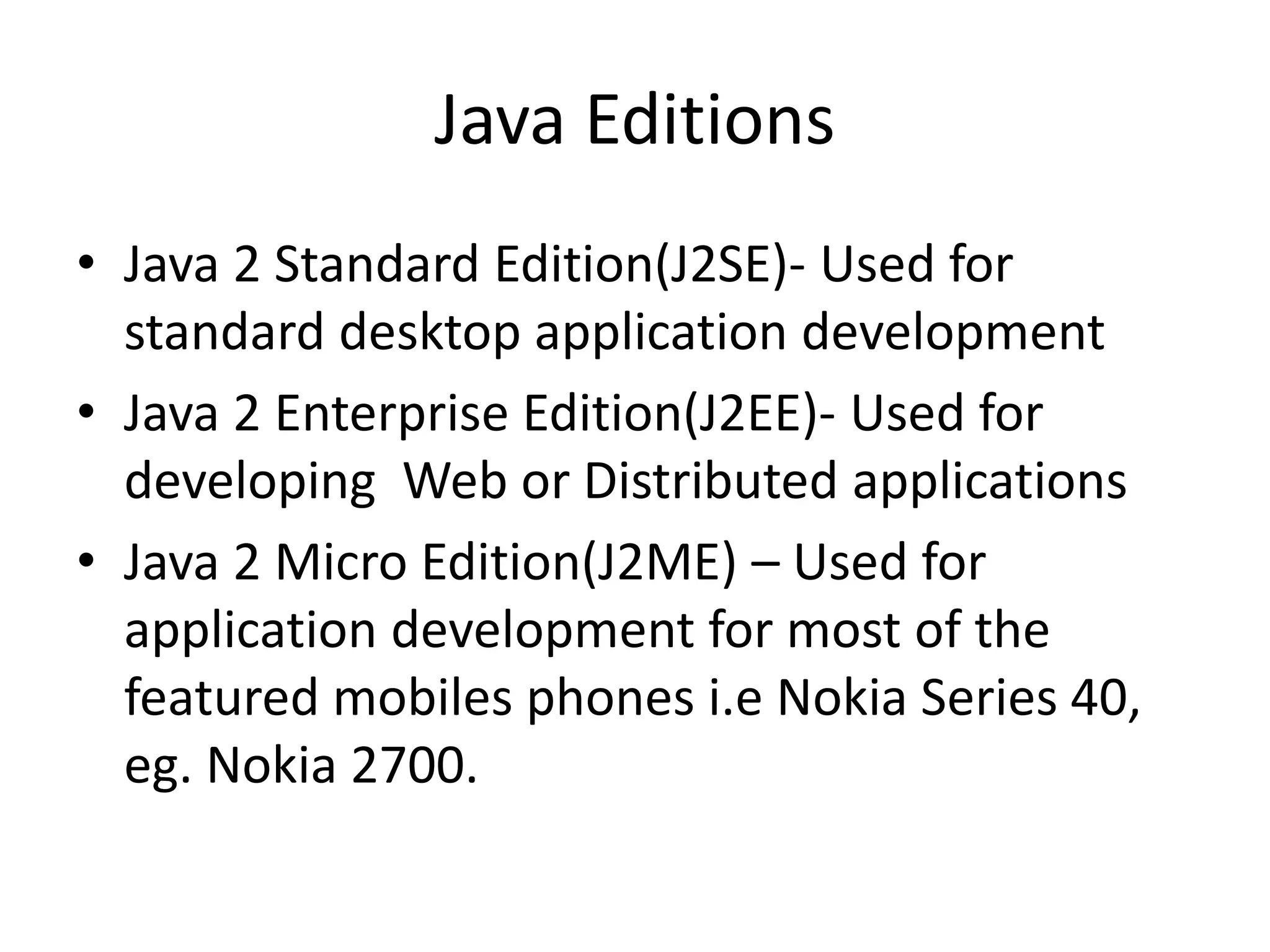
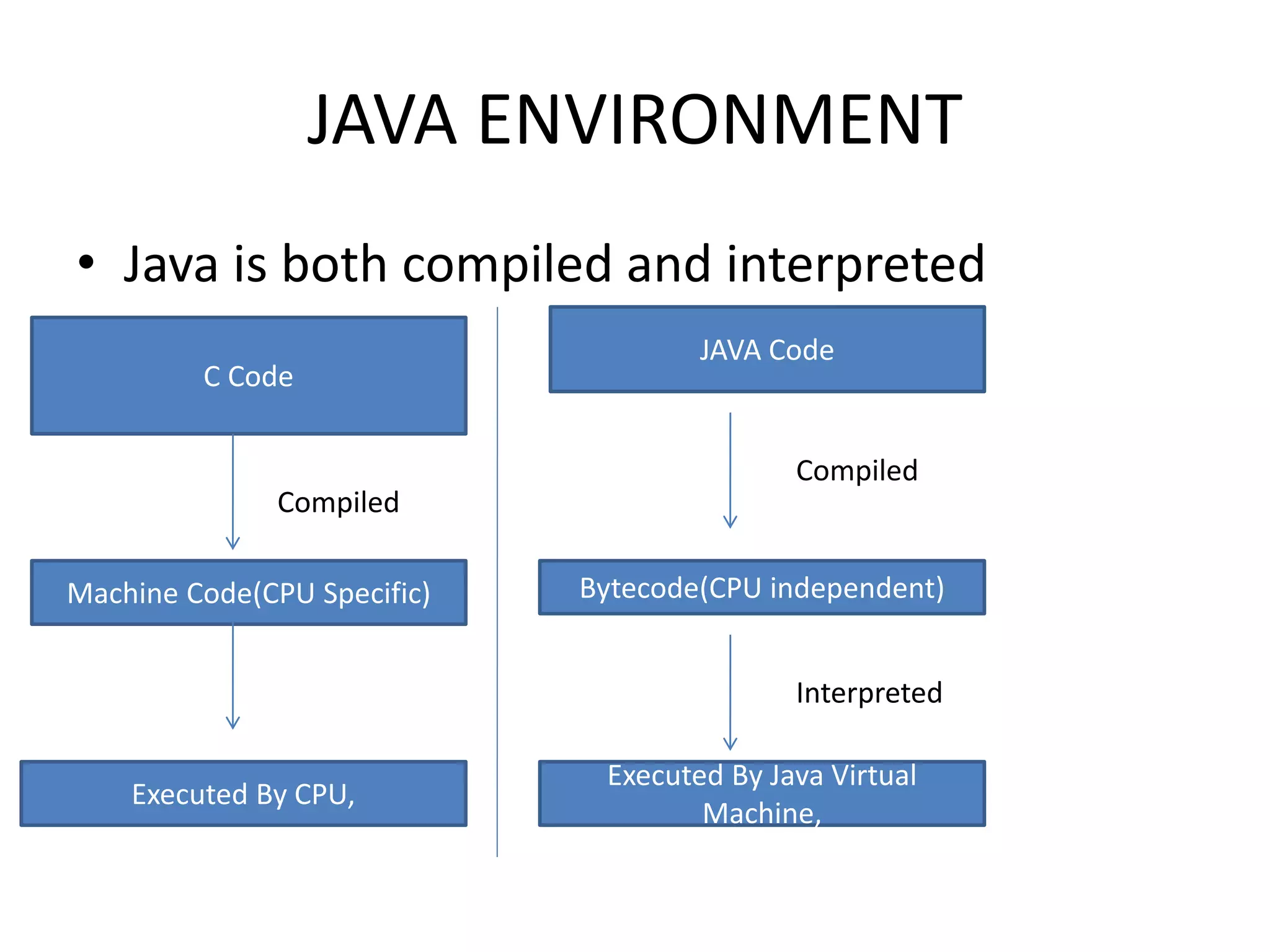
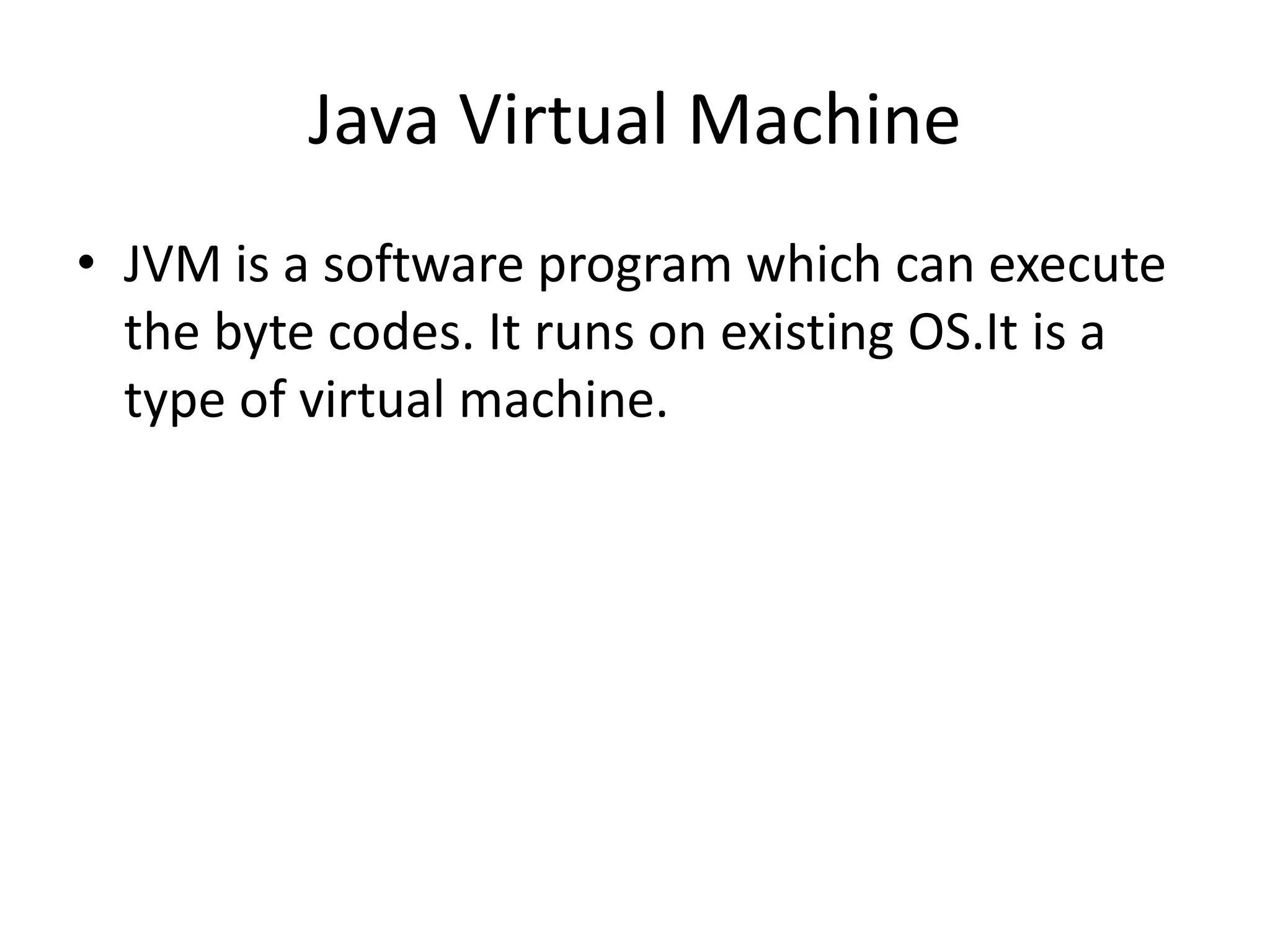
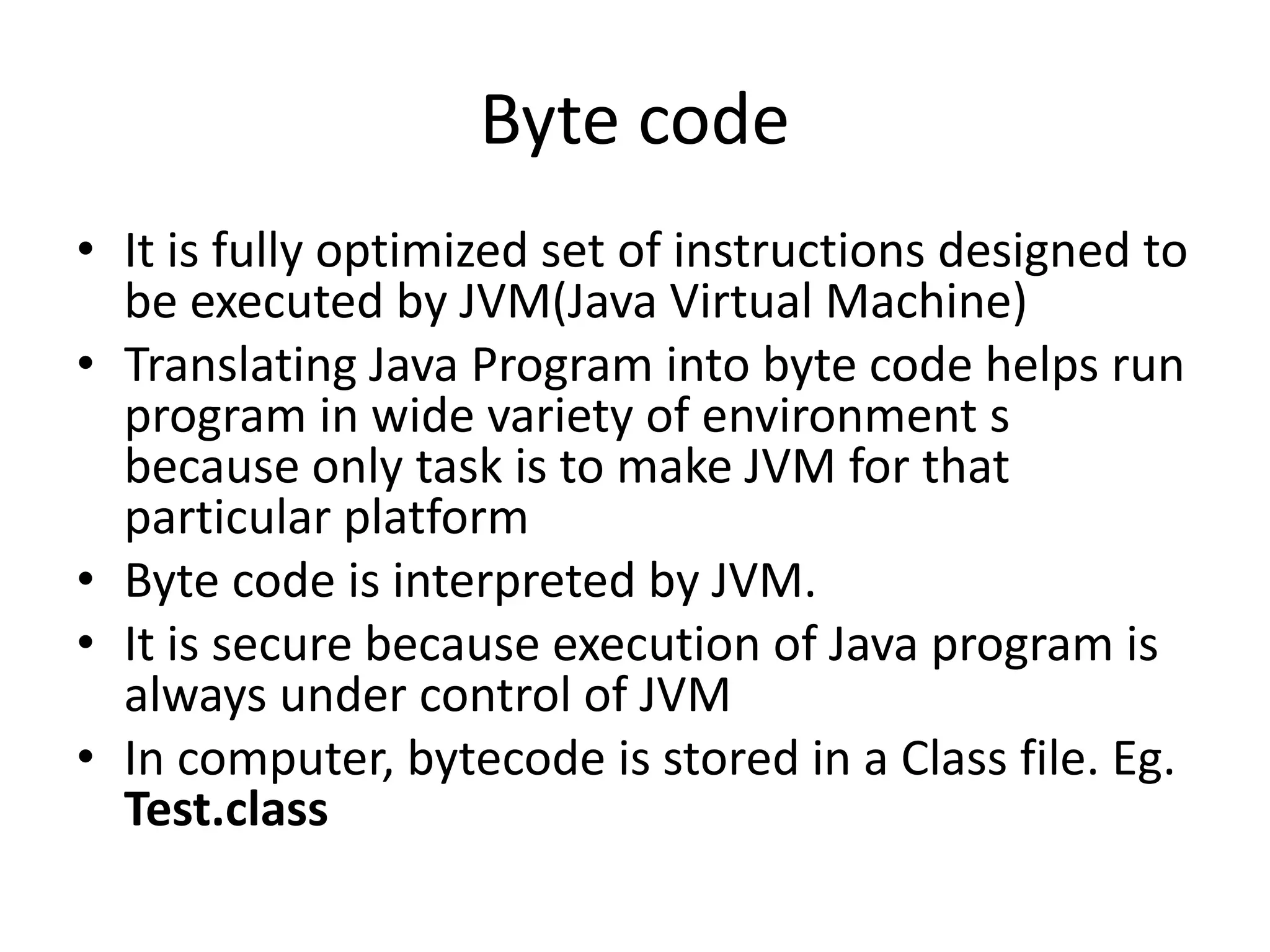
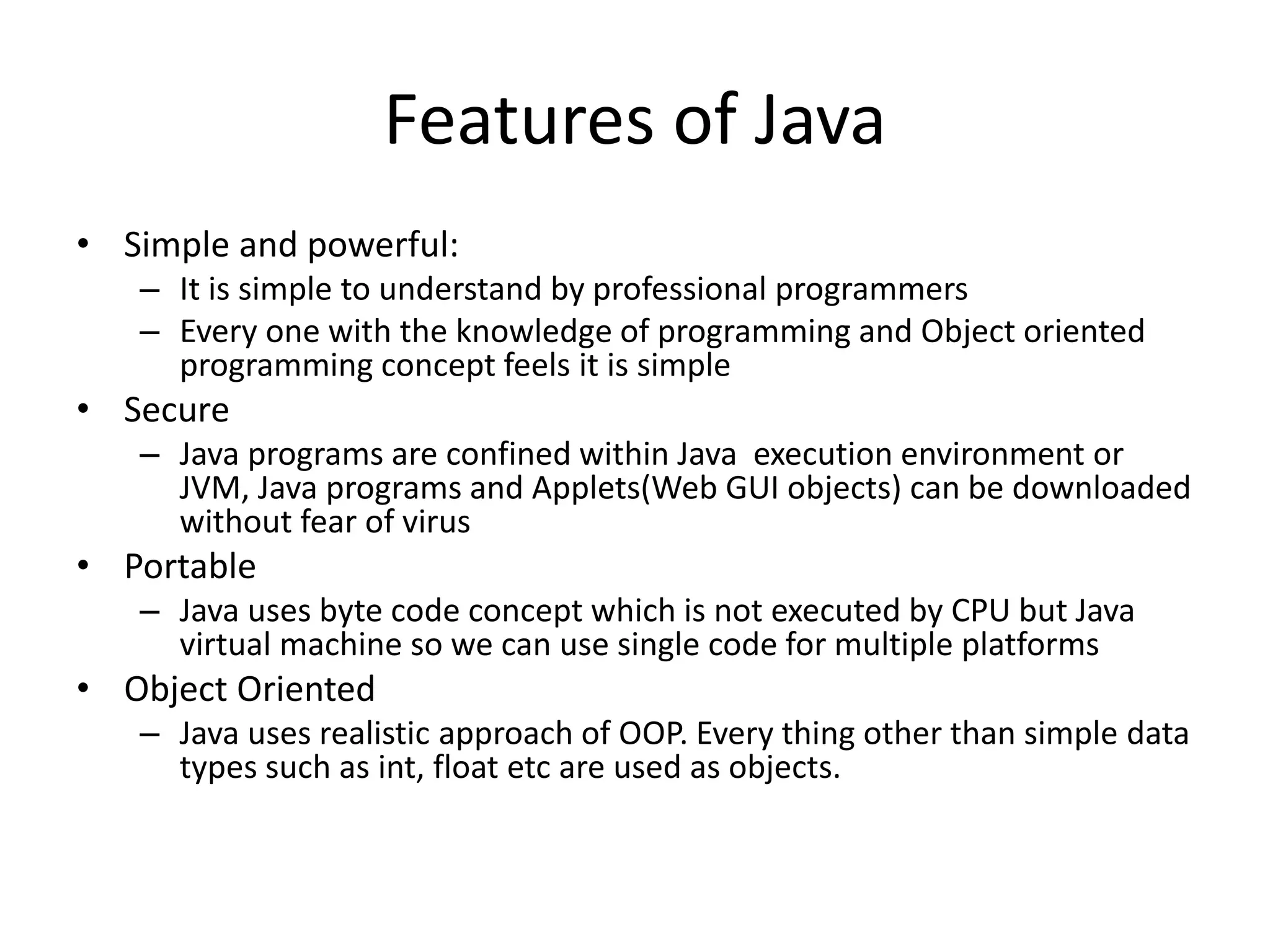
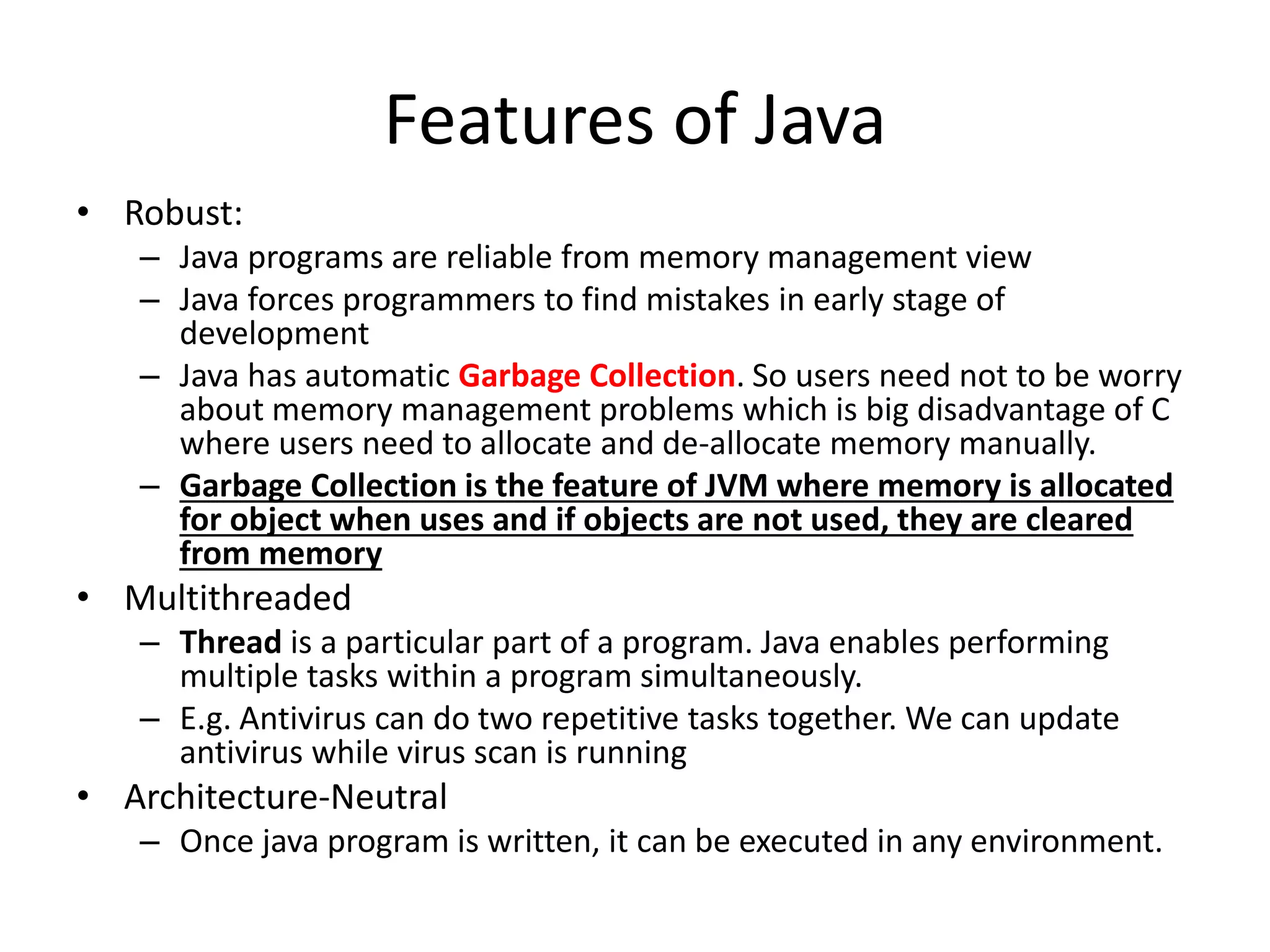
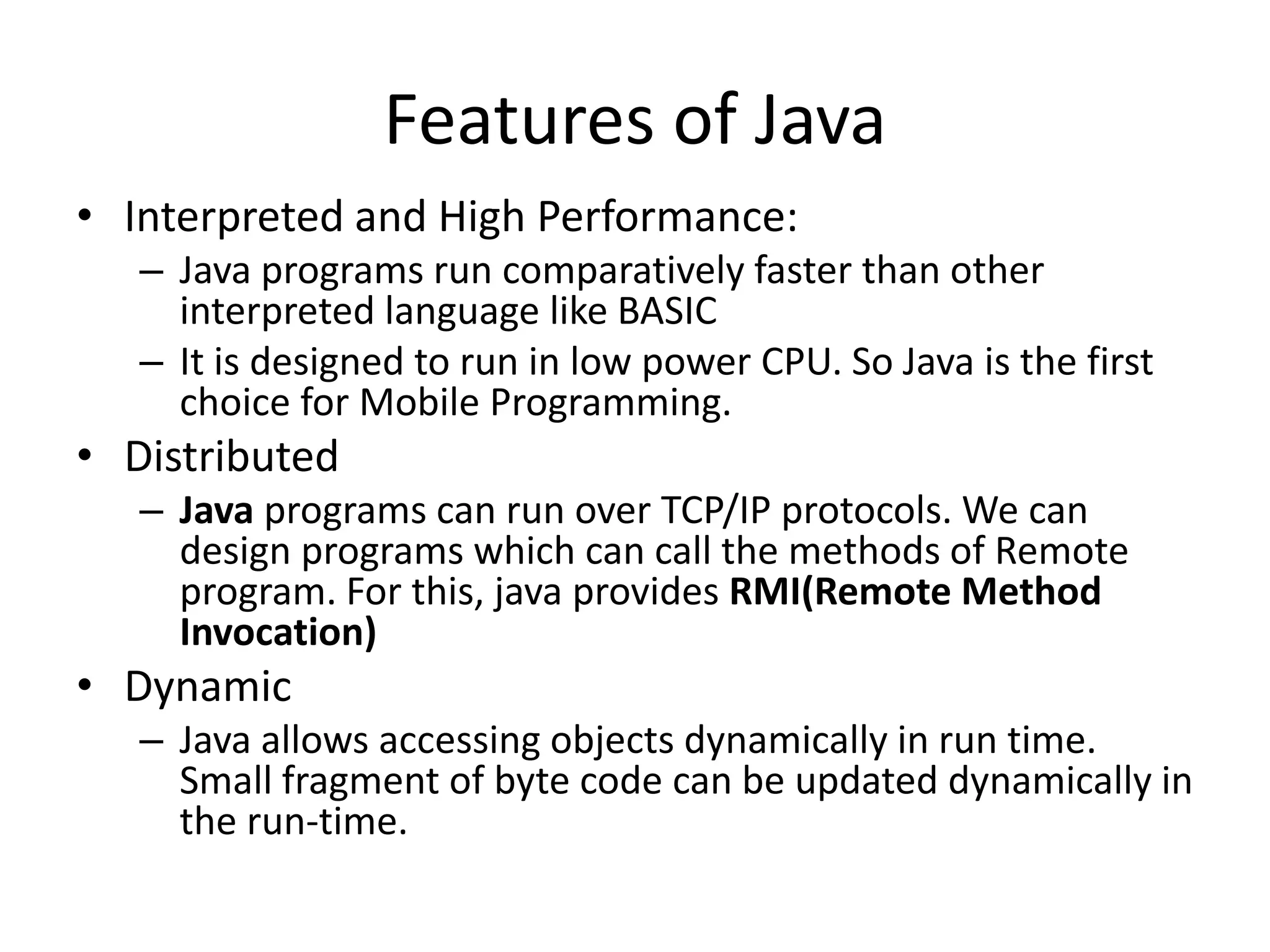
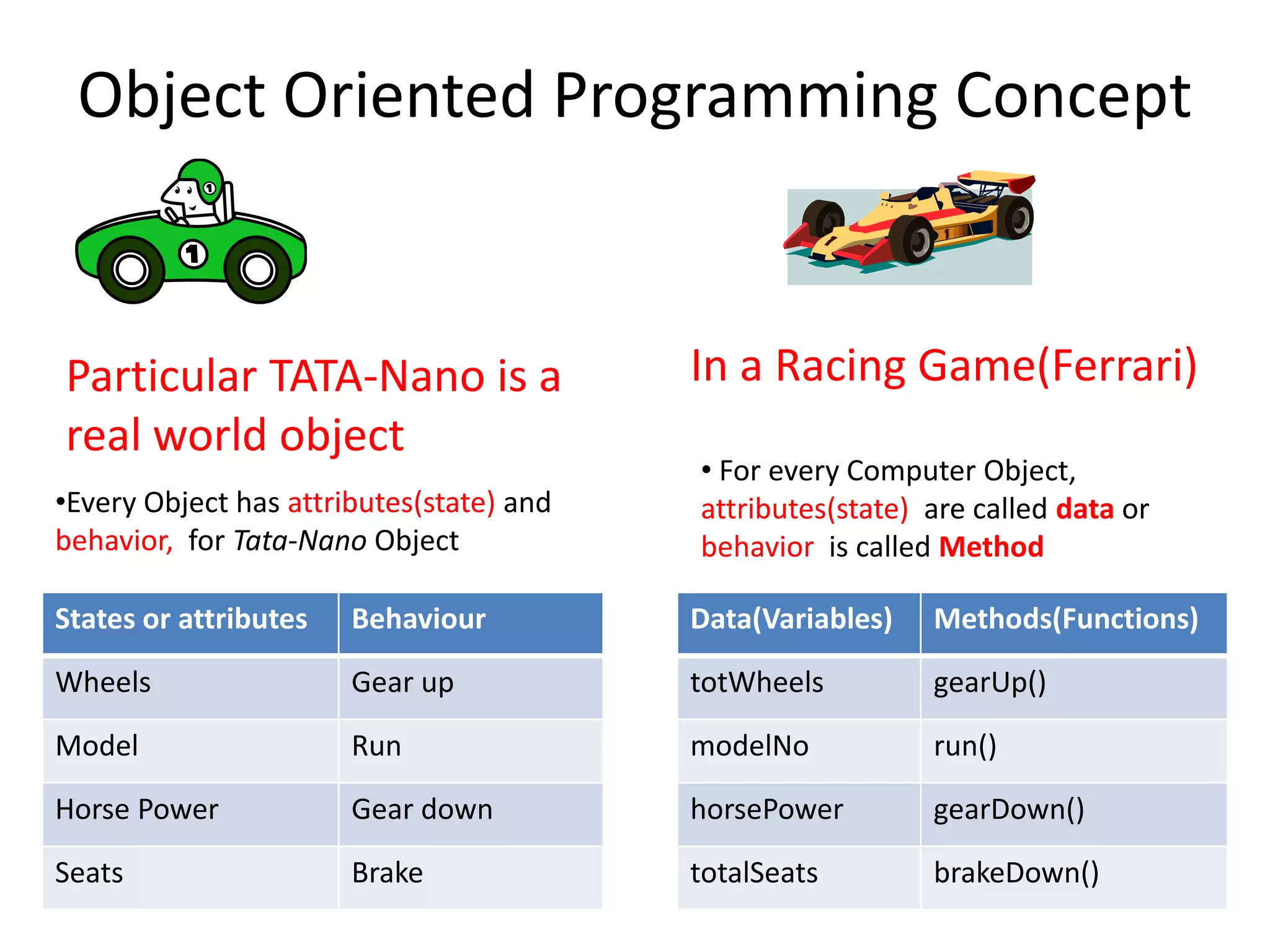
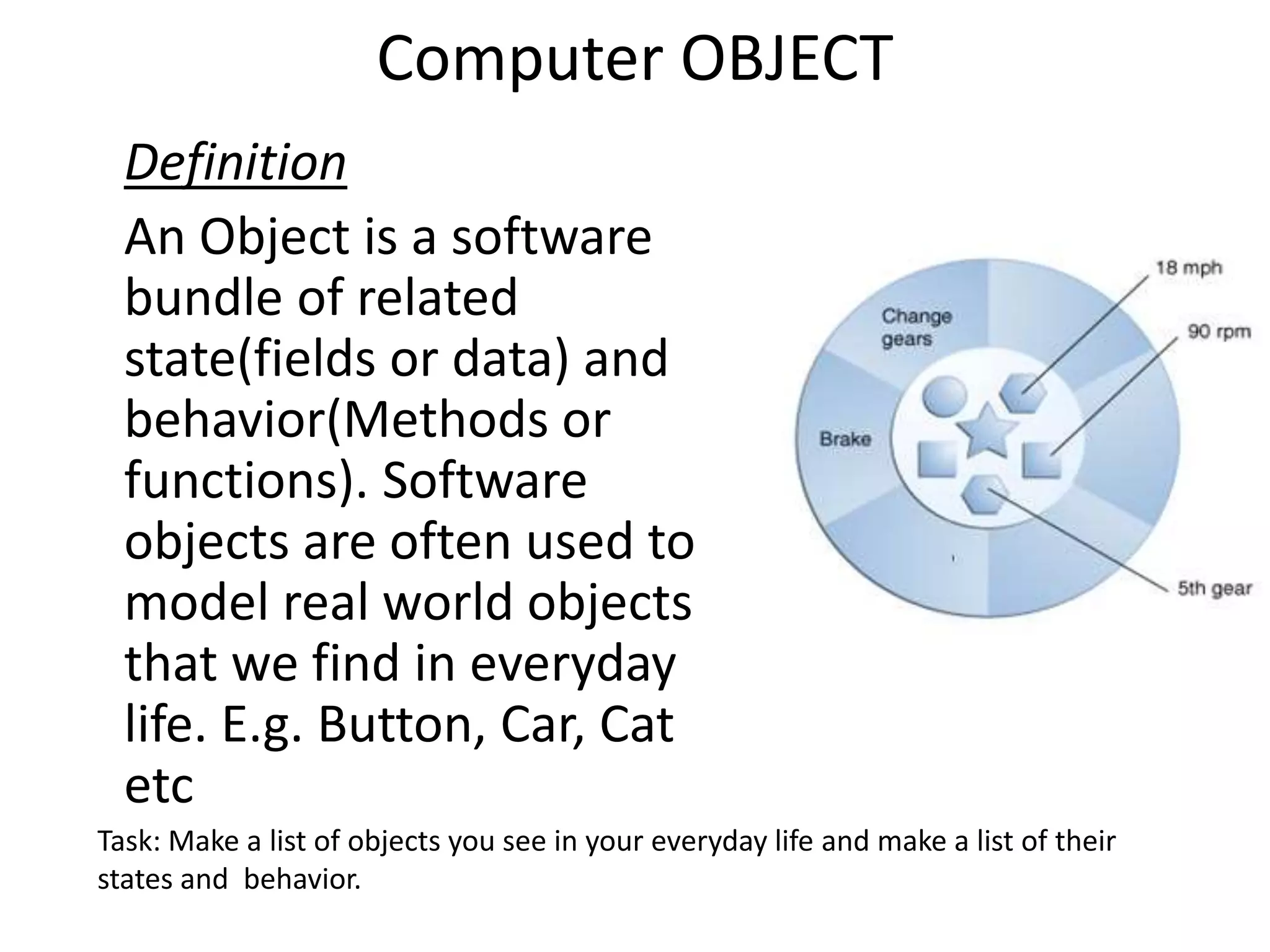
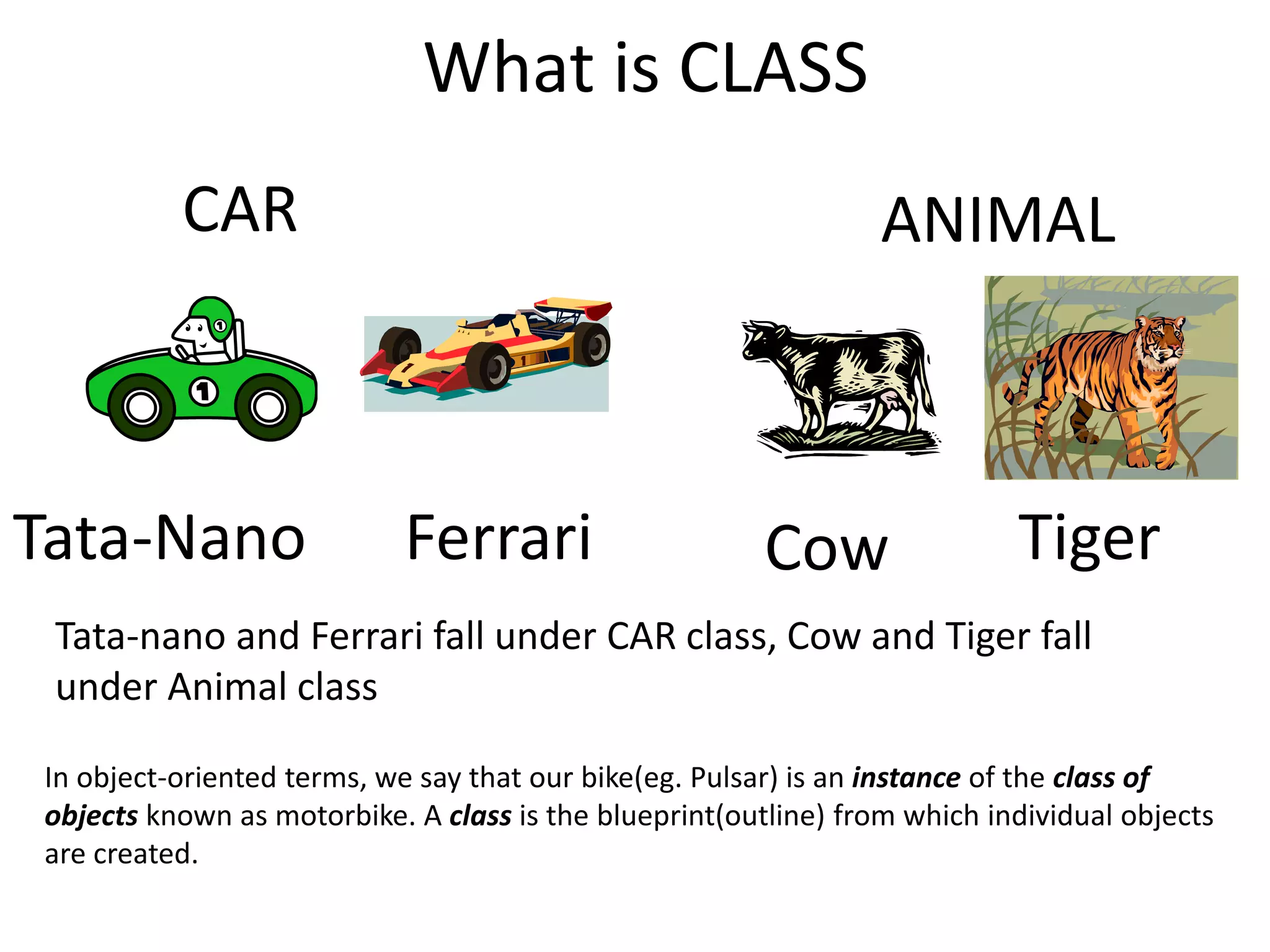
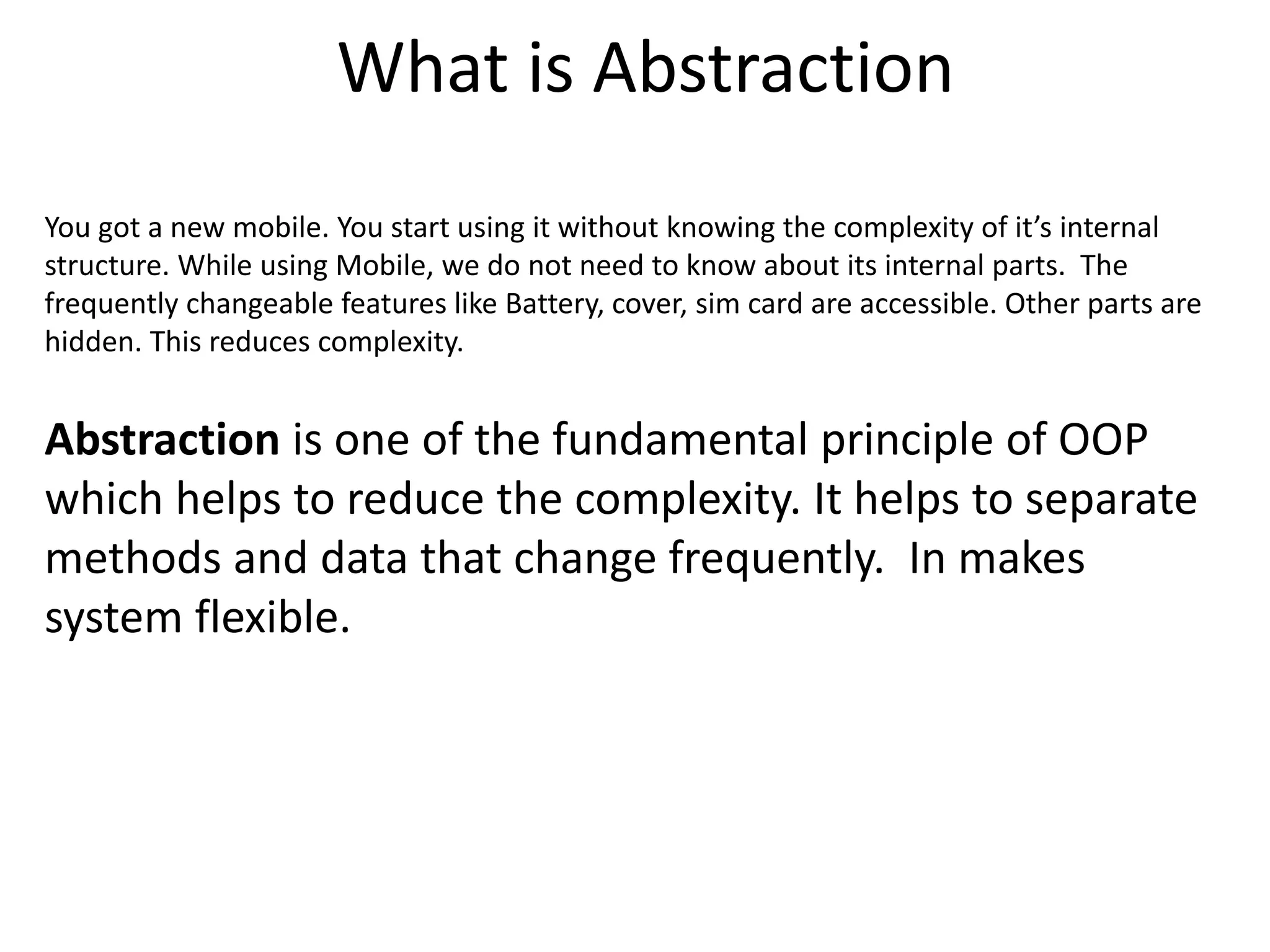
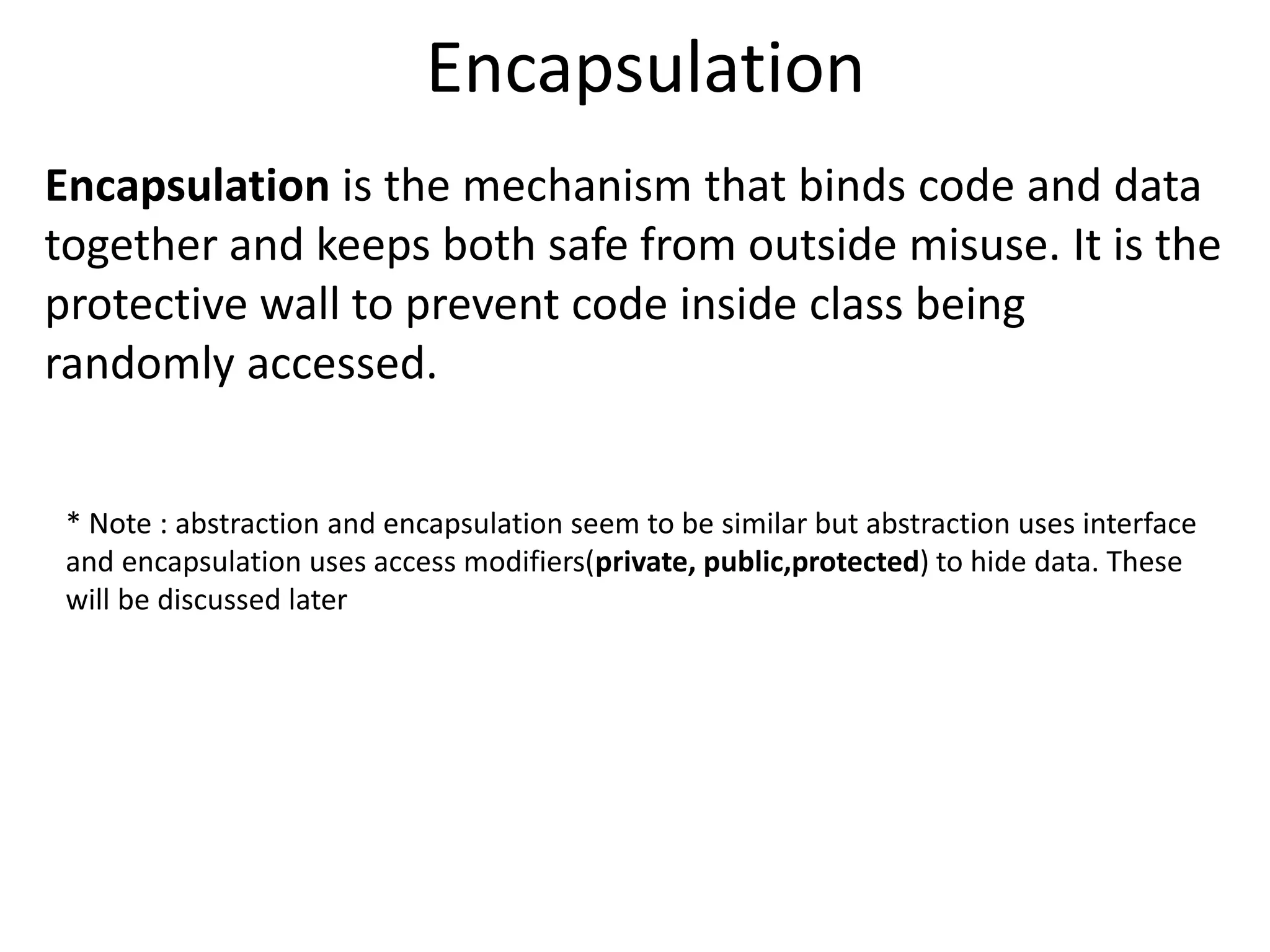
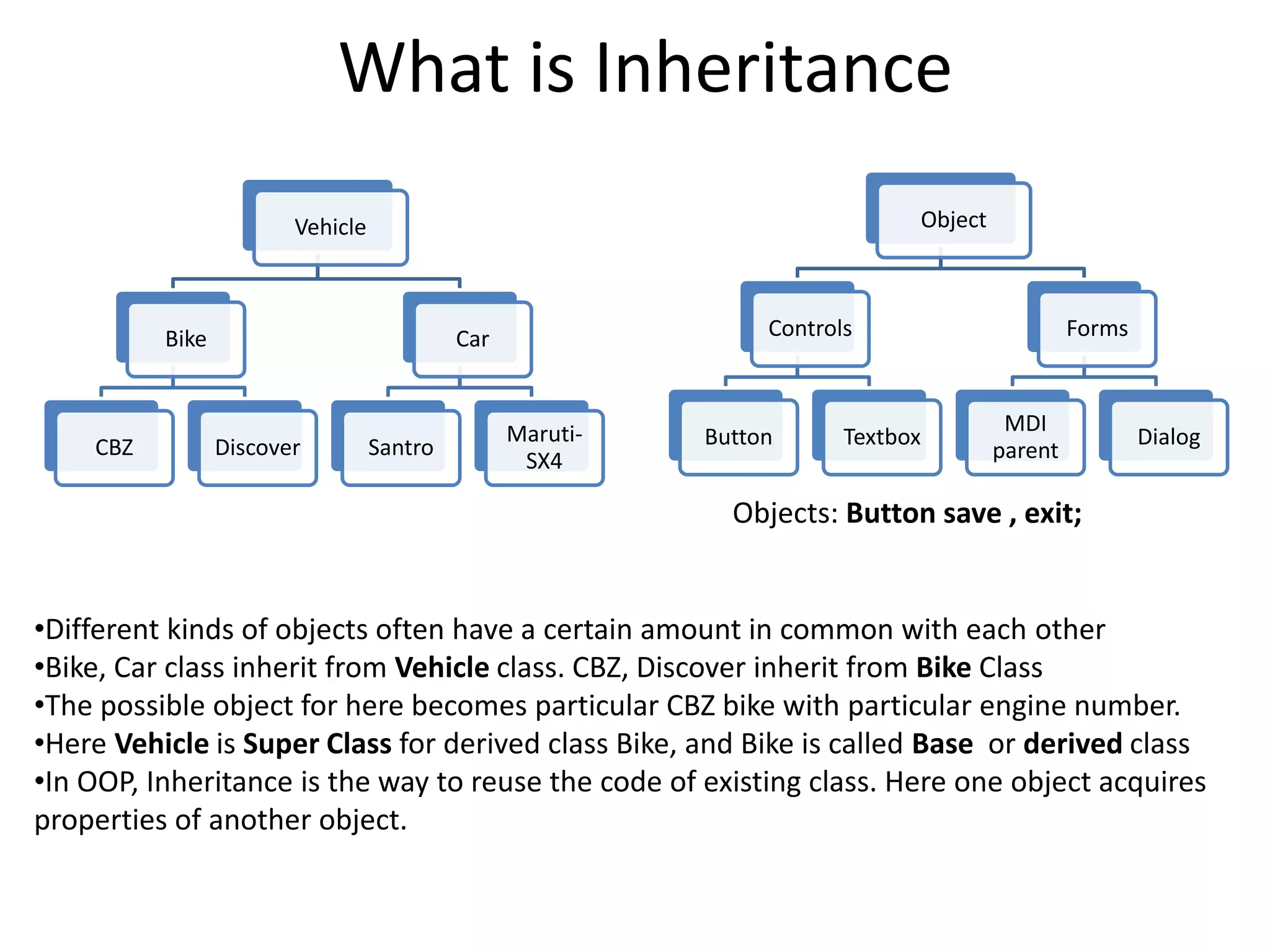
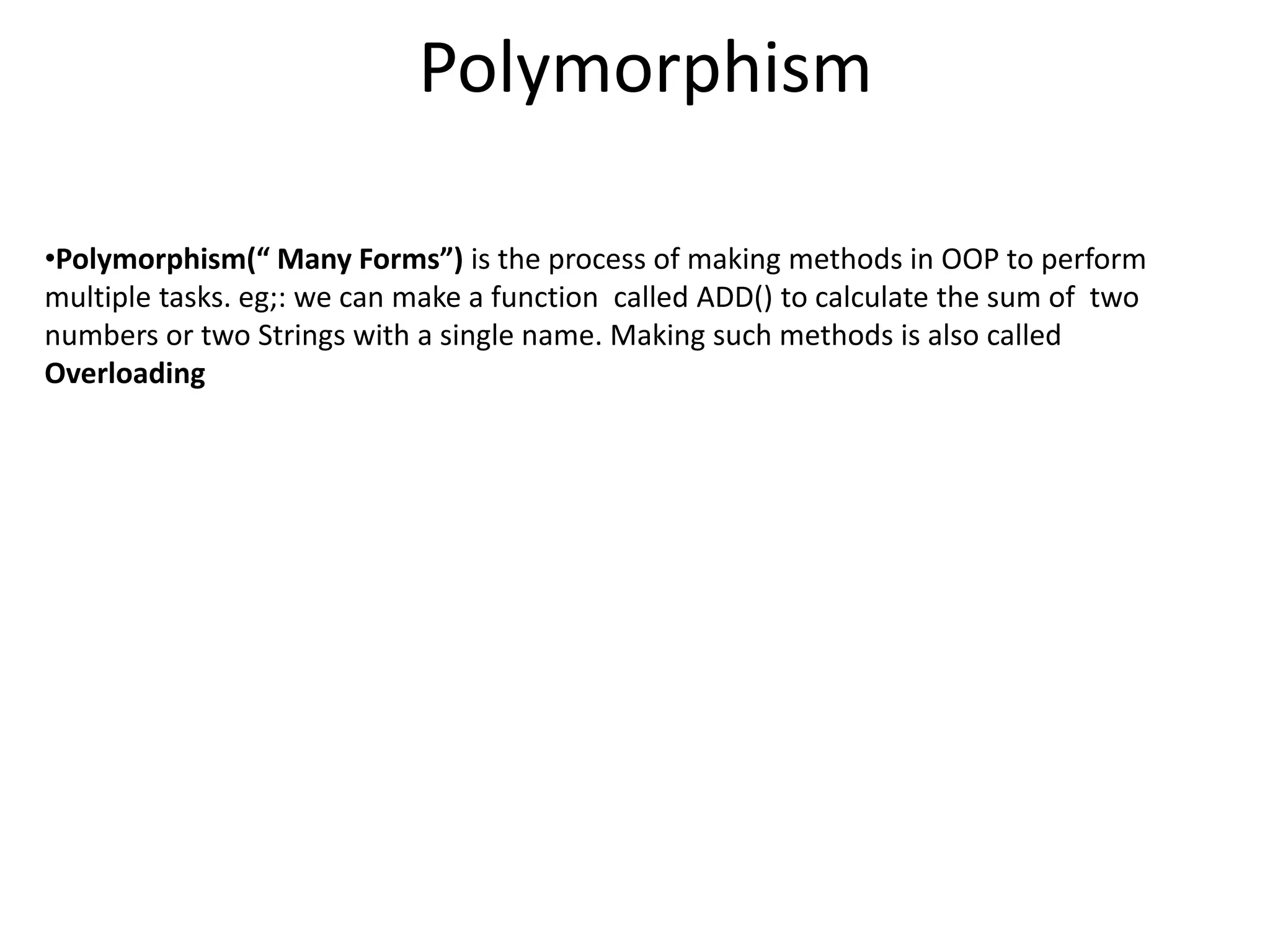
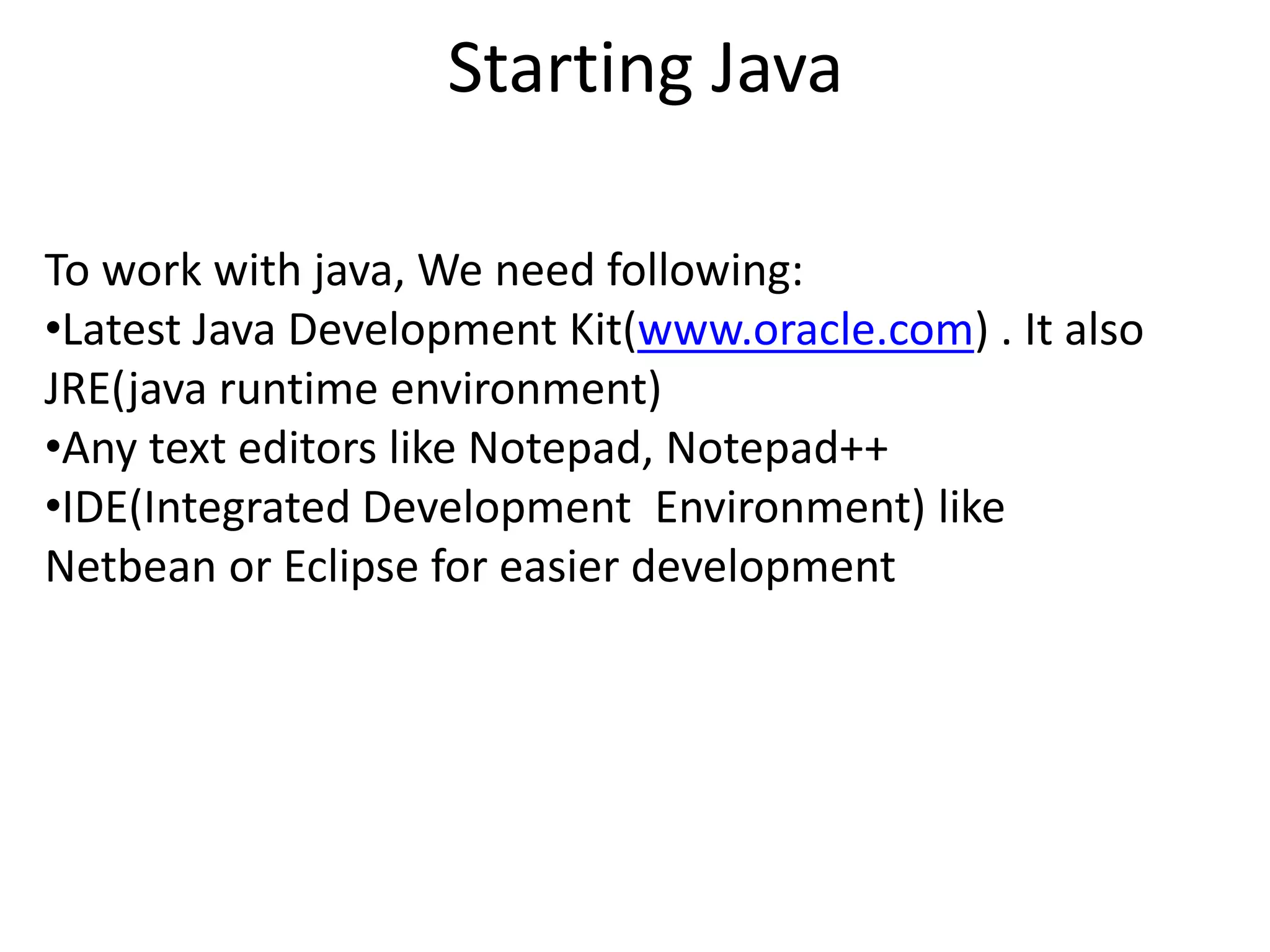
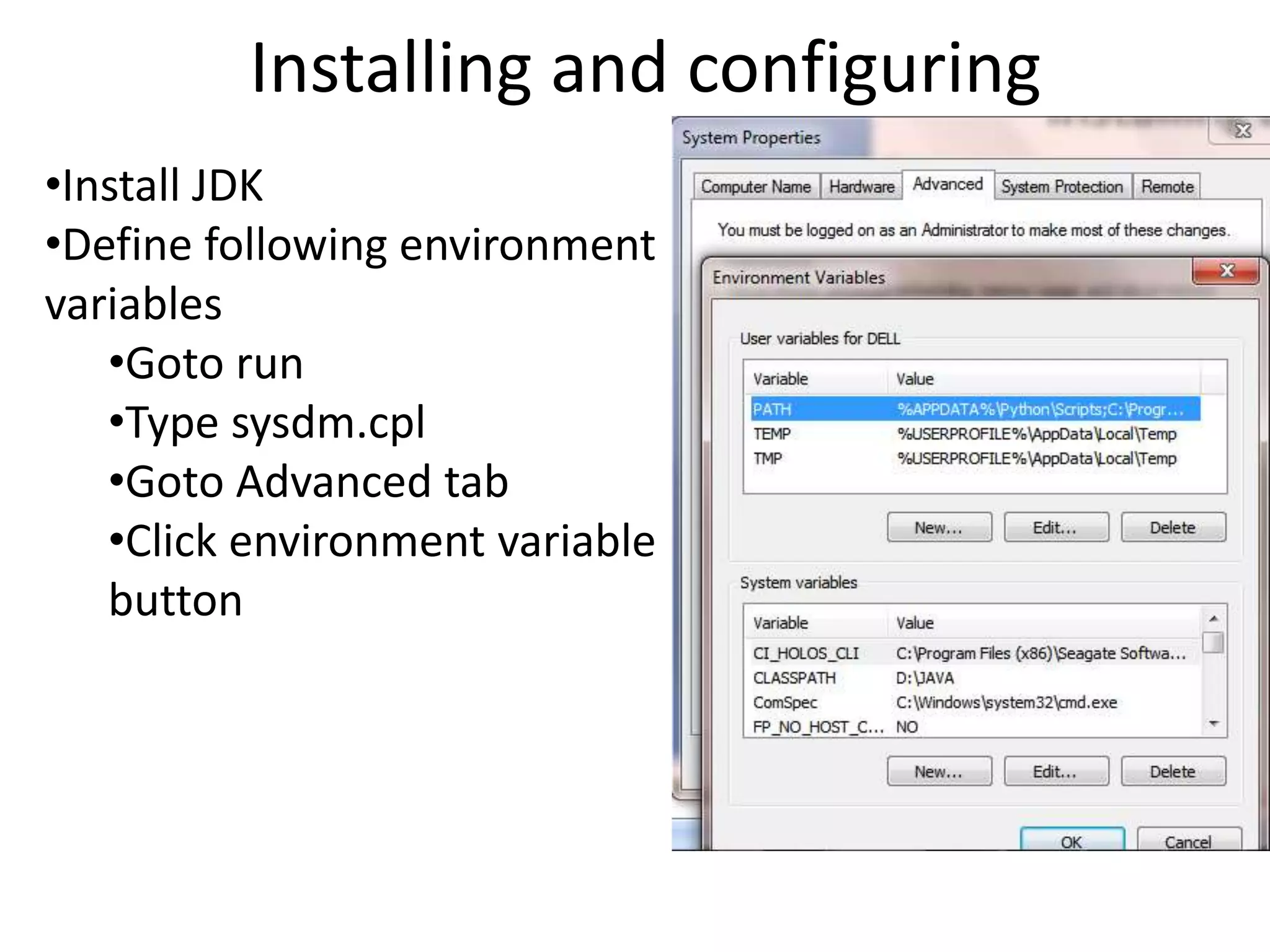
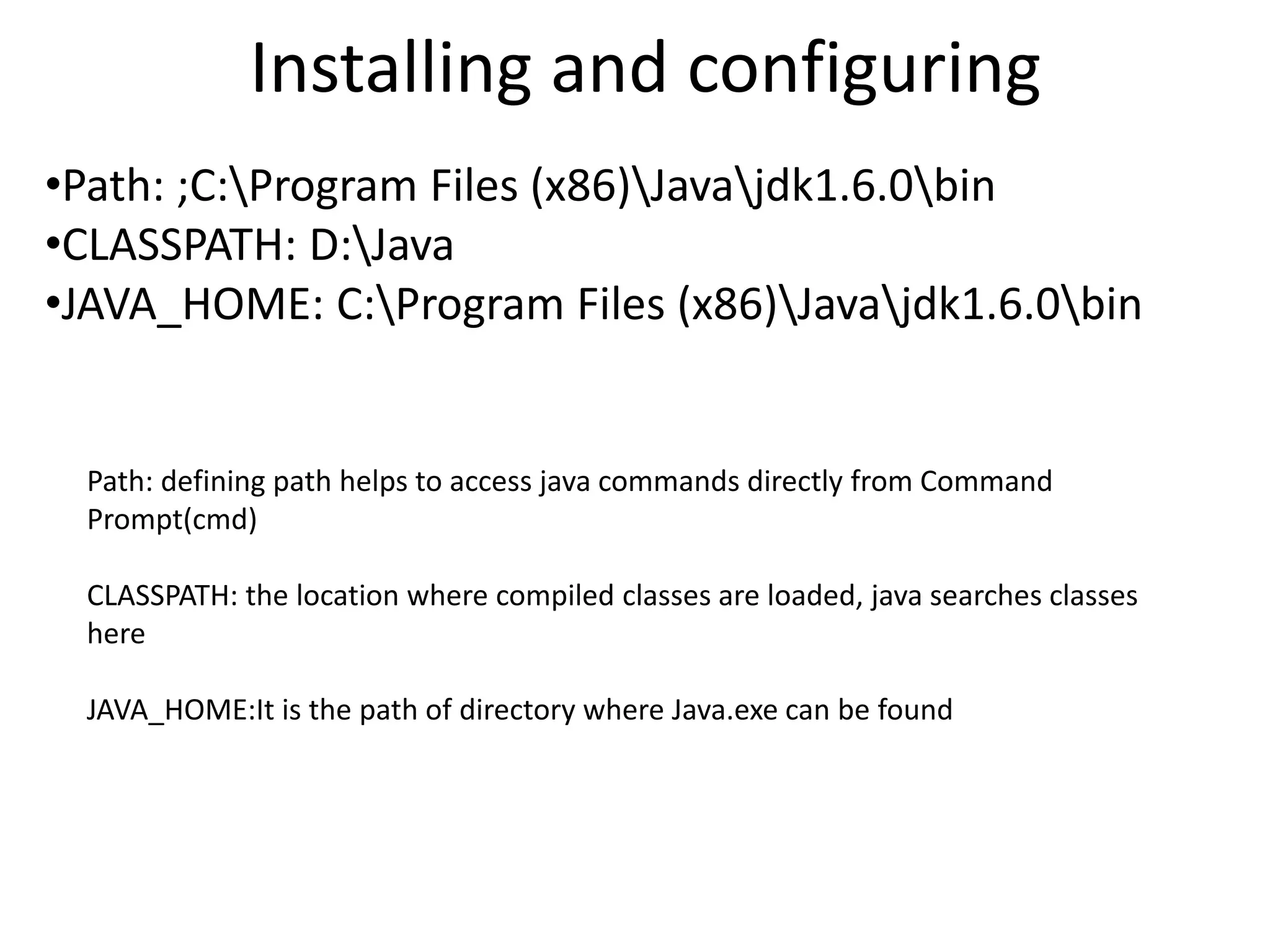
![First Java Program //class name is First so save file as First.java class First{ public static void main(String args[]) { System.out.println(“First Program”); } } •Save file as First.java • compile: •D:/java>javac First.java •Run •D:/java>java First First Program](https://image.slidesharecdn.com/letest-150709131822-lva1-app6891/75/Java-Programming-concept-21-2048.jpg)
![First Java Program class First { It defines the name of the class // this is single line comment /* thi is multi line Comment */ public static void main(String args[]){ •public : It is public access modifier which can be called from outside. •Static : this keyword tells that to call main() function, instance of First is not required. Every static data members can be directly accessed without creating object of class. •void refers an empty data type so this function does not return any value •main()- the function that is called automatically when application is launched •args[]-these are number of values which can be passed into program. •For example: •C:/>format c: enter •Here c: is an argument Enter](https://image.slidesharecdn.com/letest-150709131822-lva1-app6891/75/Java-Programming-concept-22-2048.jpg)
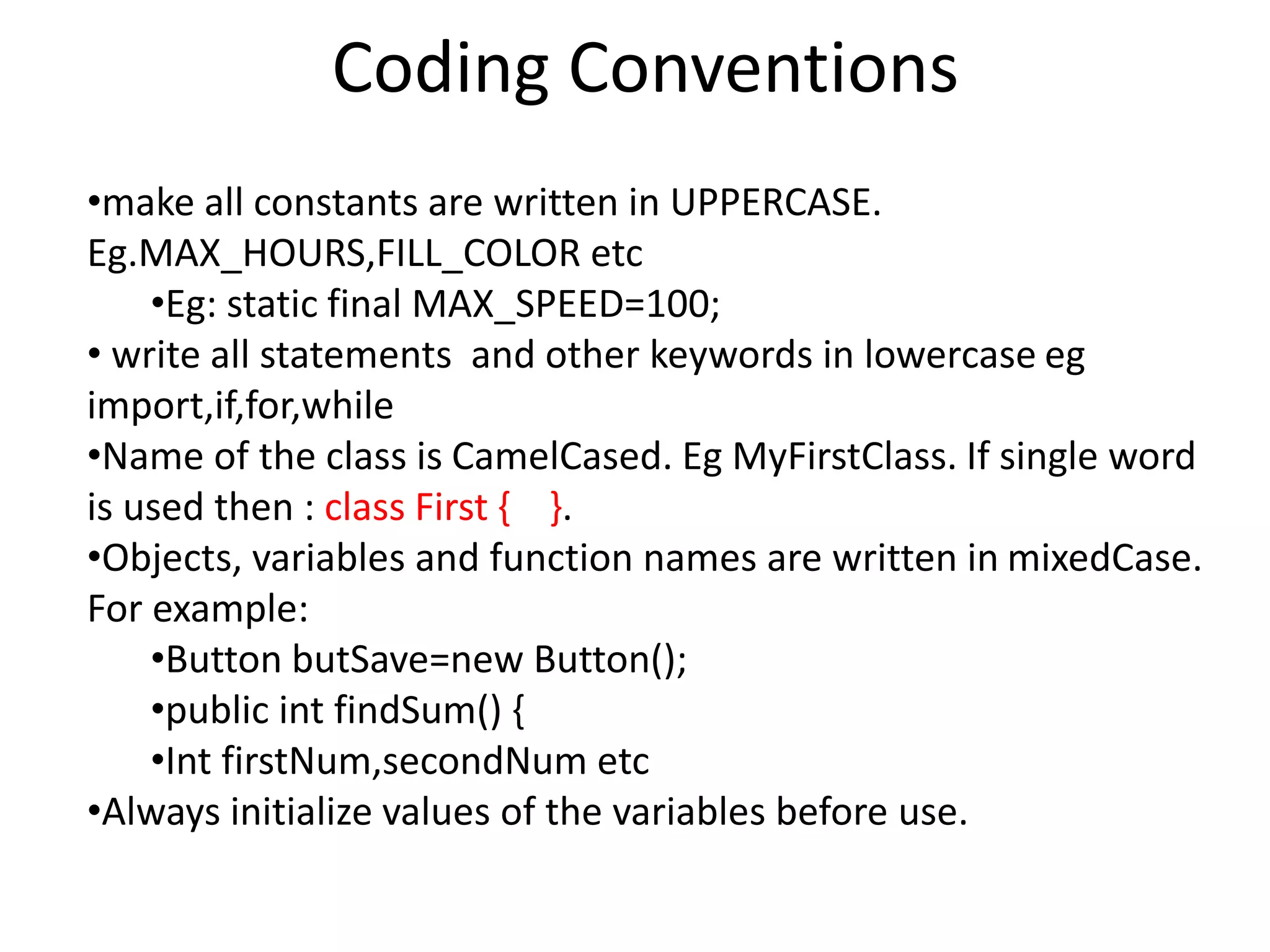
![Second Java Program //class name is First so save file as SecondJava.java class SecondJava{ public static void main(String args[]) { int age=10; System.out.println(“I am ”+age+” years old. After 10 years, I will be “+(age+10)+” years old”); } } •Save file as SecondJava.java • compile: •D:/java>javac SecondJava.java •Run •D:/java>java SecondJava I am 10 years old. After 10 years, I will be 20 years old](https://image.slidesharecdn.com/letest-150709131822-lva1-app6891/75/Java-Programming-concept-24-2048.jpg)
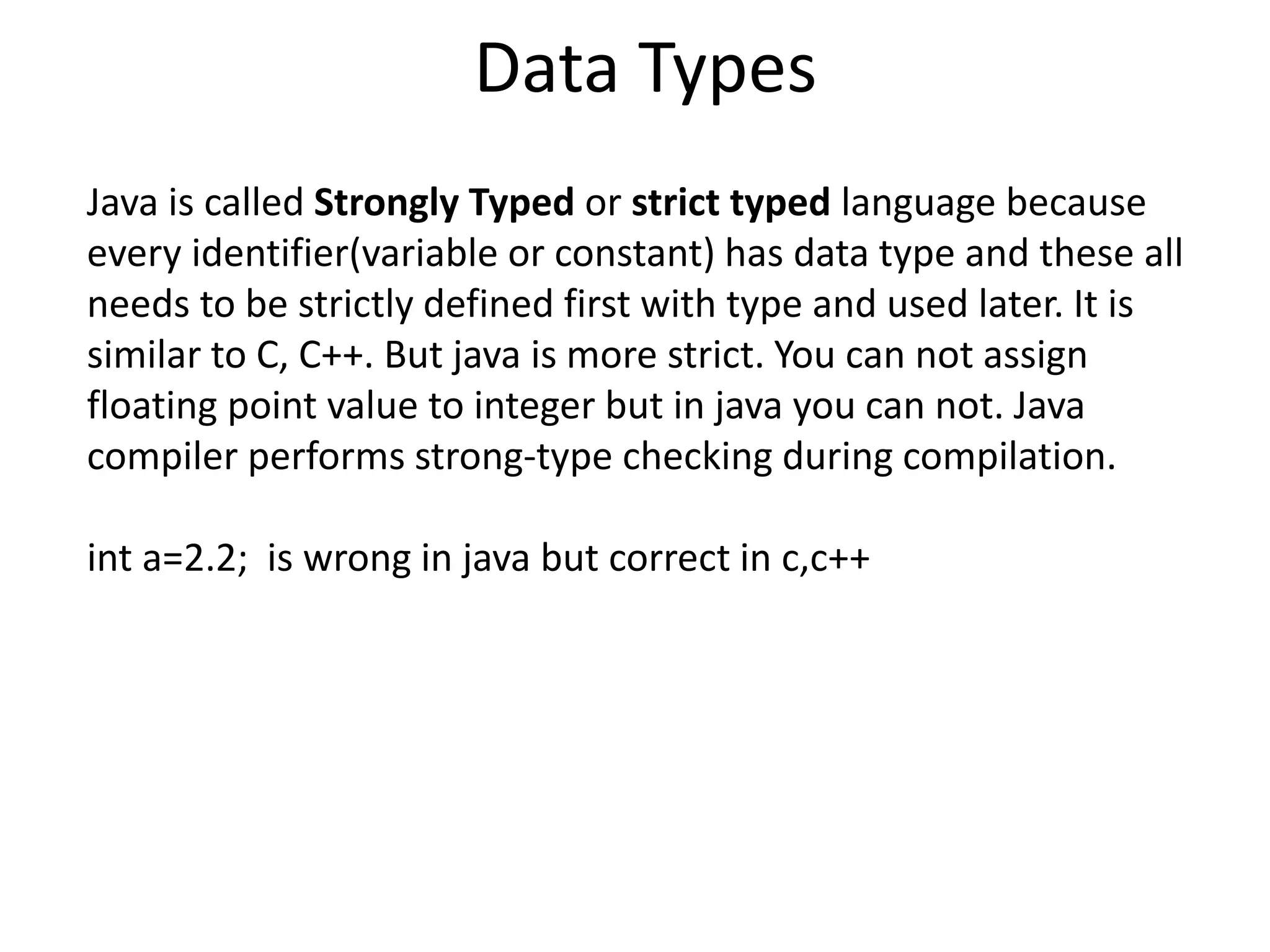
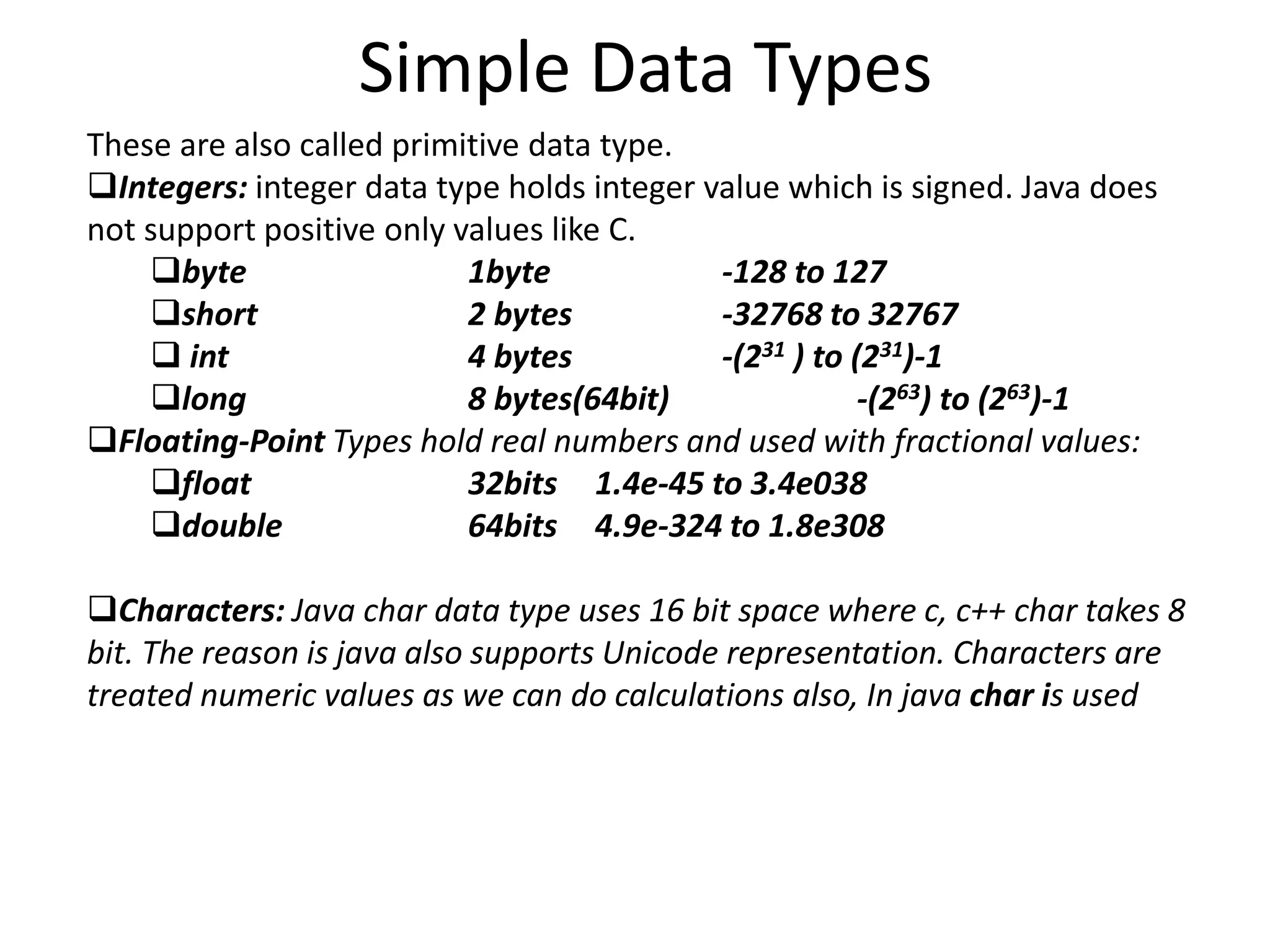
![Simple Data Types Boolean: Boolean holds logical values such as true or false. It occupies 1 bit storage class CharTest{ public static void main(String args[]) { char a='A'; char b=66; System.out.printf("a is %c and b is %c ",a,b); ++b; System.out.println(" and after increment, b is "+b); } } Output is : a is A and b is B and after increment, b is C](https://image.slidesharecdn.com/letest-150709131822-lva1-app6891/75/Java-Programming-concept-27-2048.jpg)
![Wrapper Class(Reference Types) There are some situations where data types are required to be true objects.eg. If we want to derive data type. For this purpose java provides wrapper classes where primitive data types are written as object, here first letter is capitalized. Eg. Integer, String, Character etc. public class First { public static void main(String args[]) { int a=10; Integer obj=new Integer(15); System.out.println("premitive is "+a+" Wrapper is "+obj.intValue()); } }](https://image.slidesharecdn.com/letest-150709131822-lva1-app6891/75/Java-Programming-concept-28-2048.jpg)
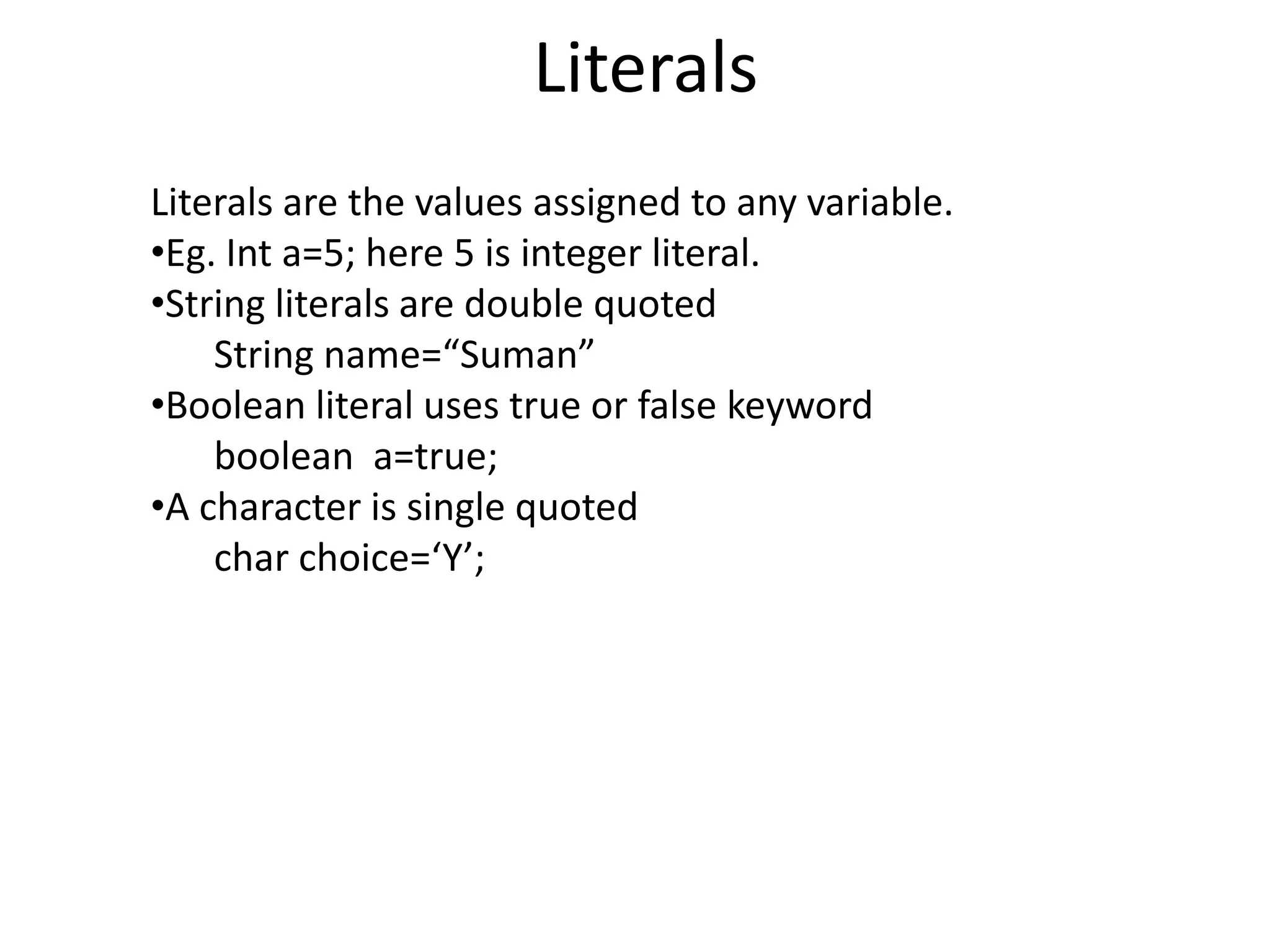
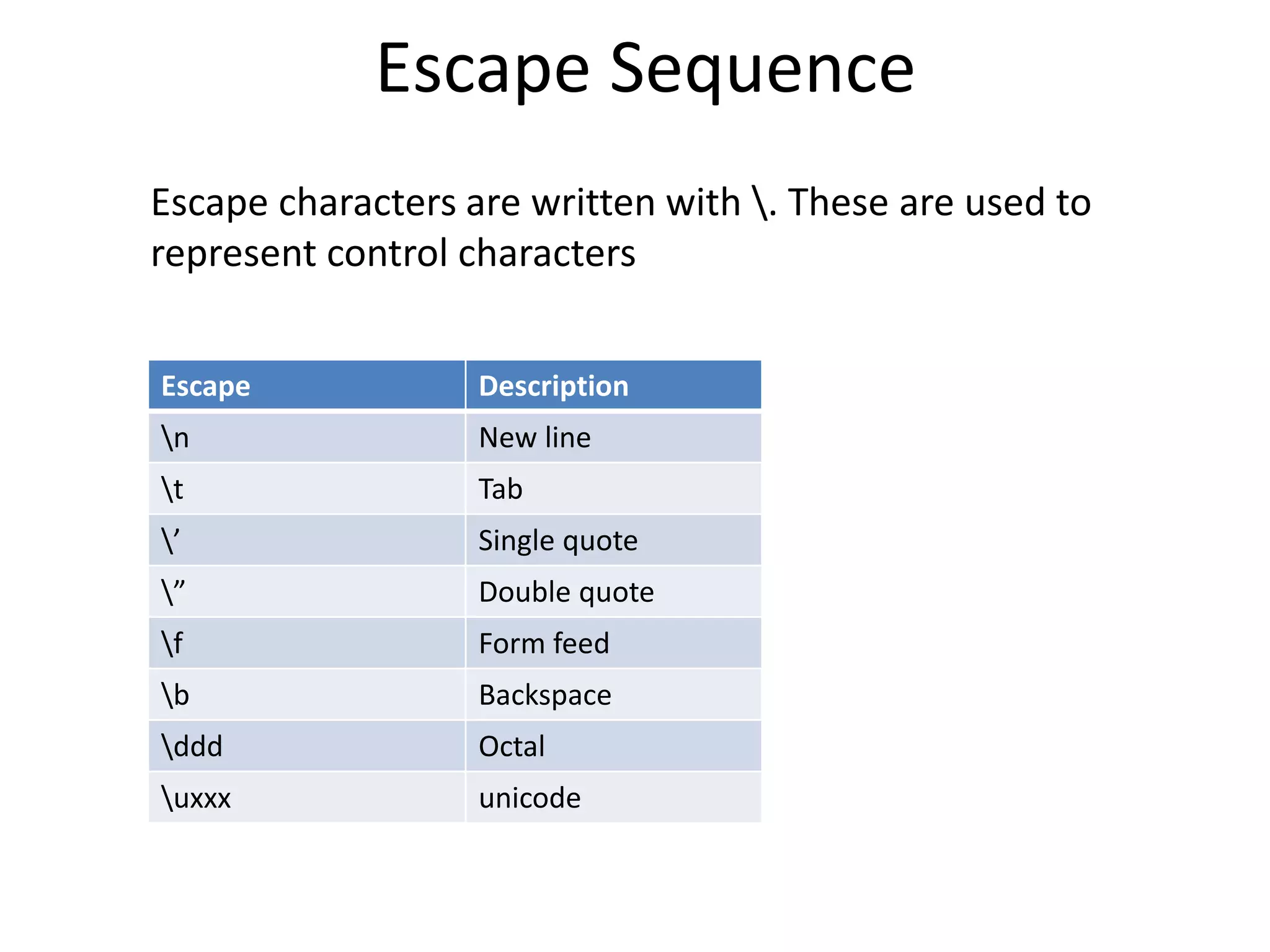
![Example public class Escape{ public static void main(String args[]) { String quote="Programming is Fun"; System.out.println("Many people say ""+quote+"""); } } Output is : Many people say “Programming is Fun”](https://image.slidesharecdn.com/letest-150709131822-lva1-app6891/75/Java-Programming-concept-31-2048.jpg)
![Variables Variable is an identifier which holds certain value that can be changed. A variable has type, scope and lifetime. Variable name can start with $ or an alphabet and can be followed by underscore. It can not contain whitespace. •Declaring variable <type> <var_name>=[<value>] Eg. Int a=5; //declared and initialized Int x,y,z; //declared only Int m,n=6; //mixed declaration and initialization Int t; // declared and later initialized t=9;](https://image.slidesharecdn.com/letest-150709131822-lva1-app6891/75/Java-Programming-concept-32-2048.jpg)
![Dynamic initialization What is dynamic initialization? Give an example. (QB) Dynamic initialization is the process of assigning value to a variable dynamically during runtime. We can not perform dynamic initialization to the variables declared with final keyword. public class Init{ public static void main(String args[]) { int a=10; // this is static initialization int b=a*10; //this is dynamic initialization System.out.println(“a is “+a+” and b is “+b); } } Output is : a is 10 and b is 100](https://image.slidesharecdn.com/letest-150709131822-lva1-app6891/75/Java-Programming-concept-33-2048.jpg)
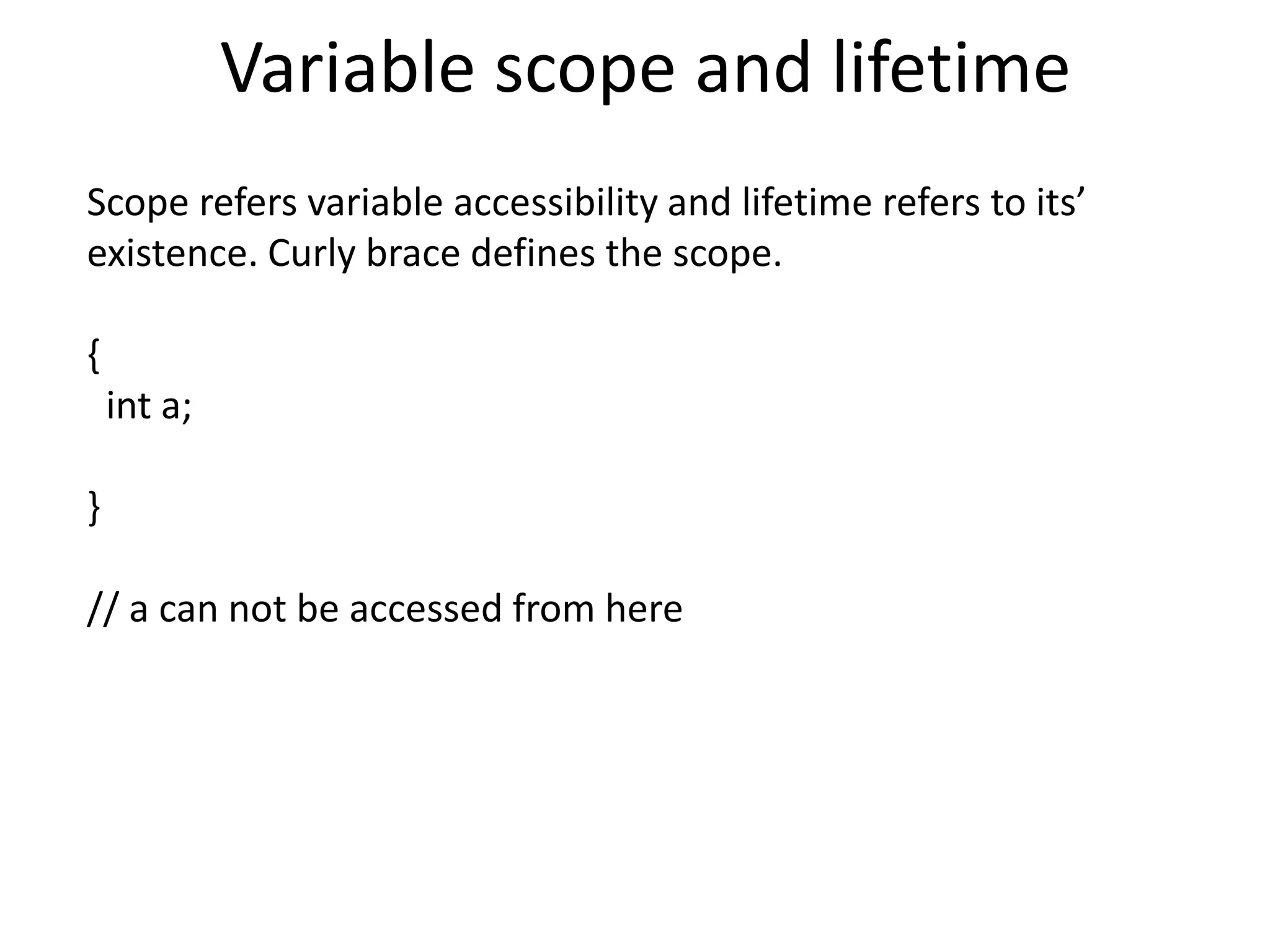
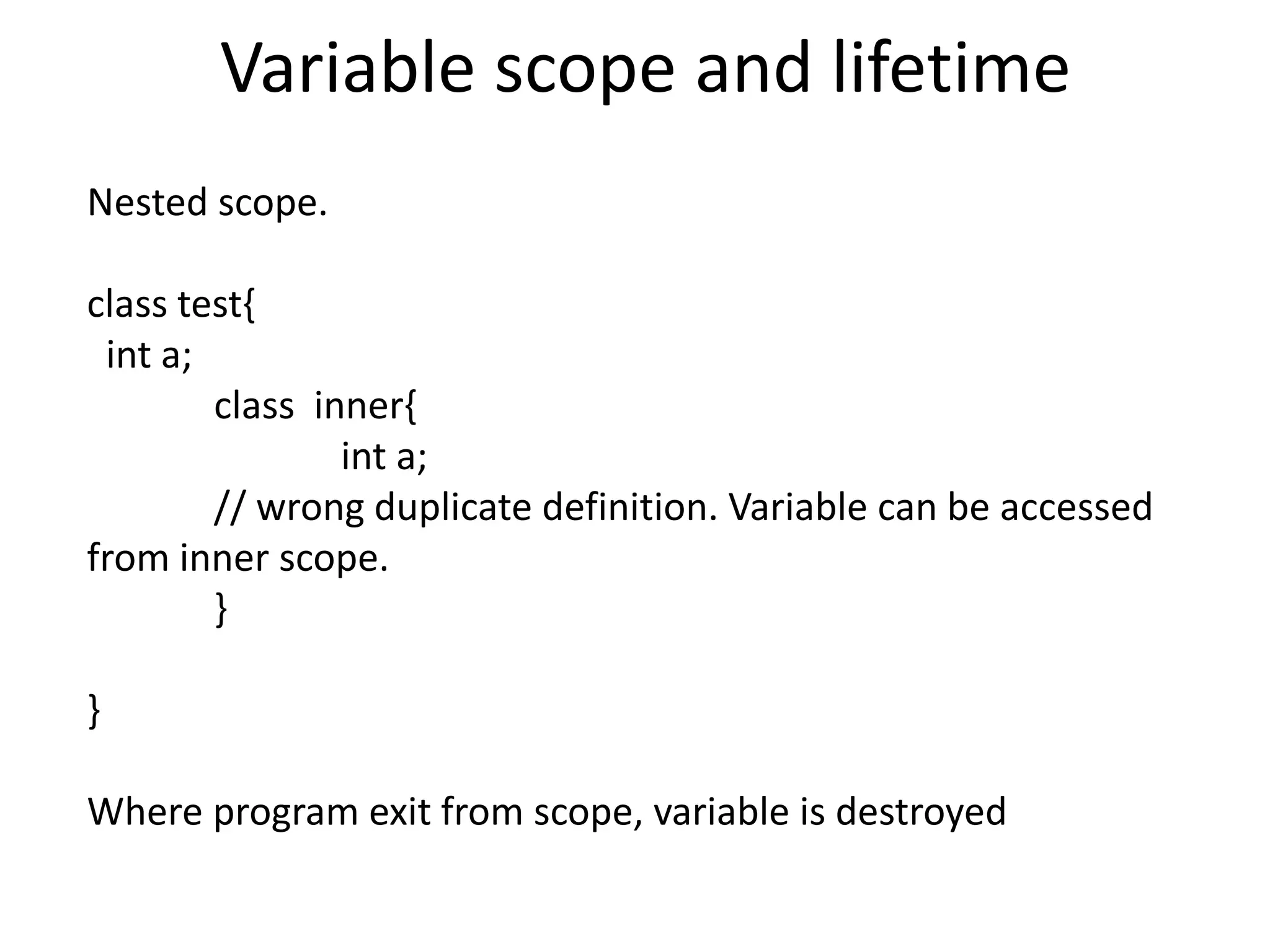
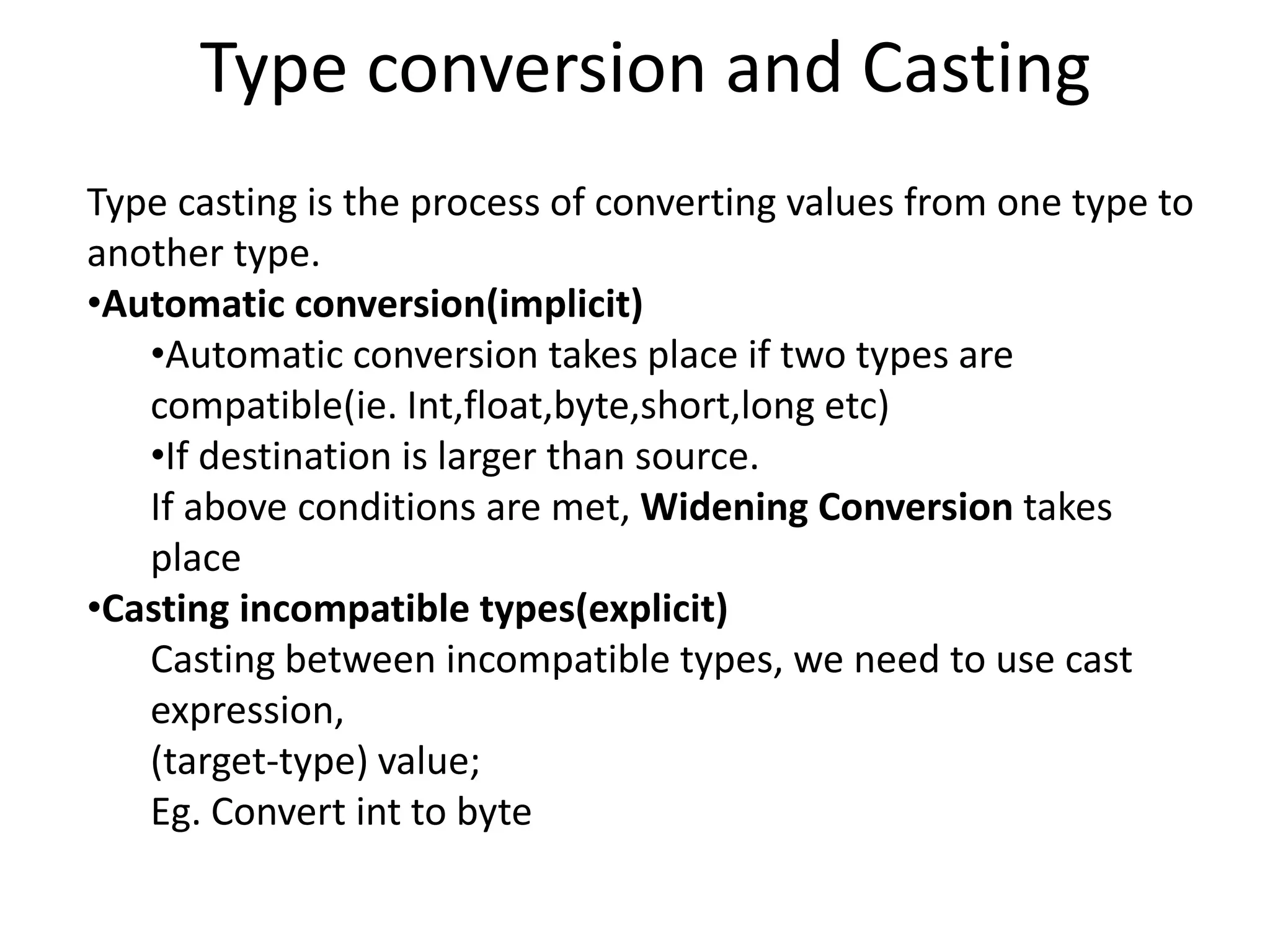
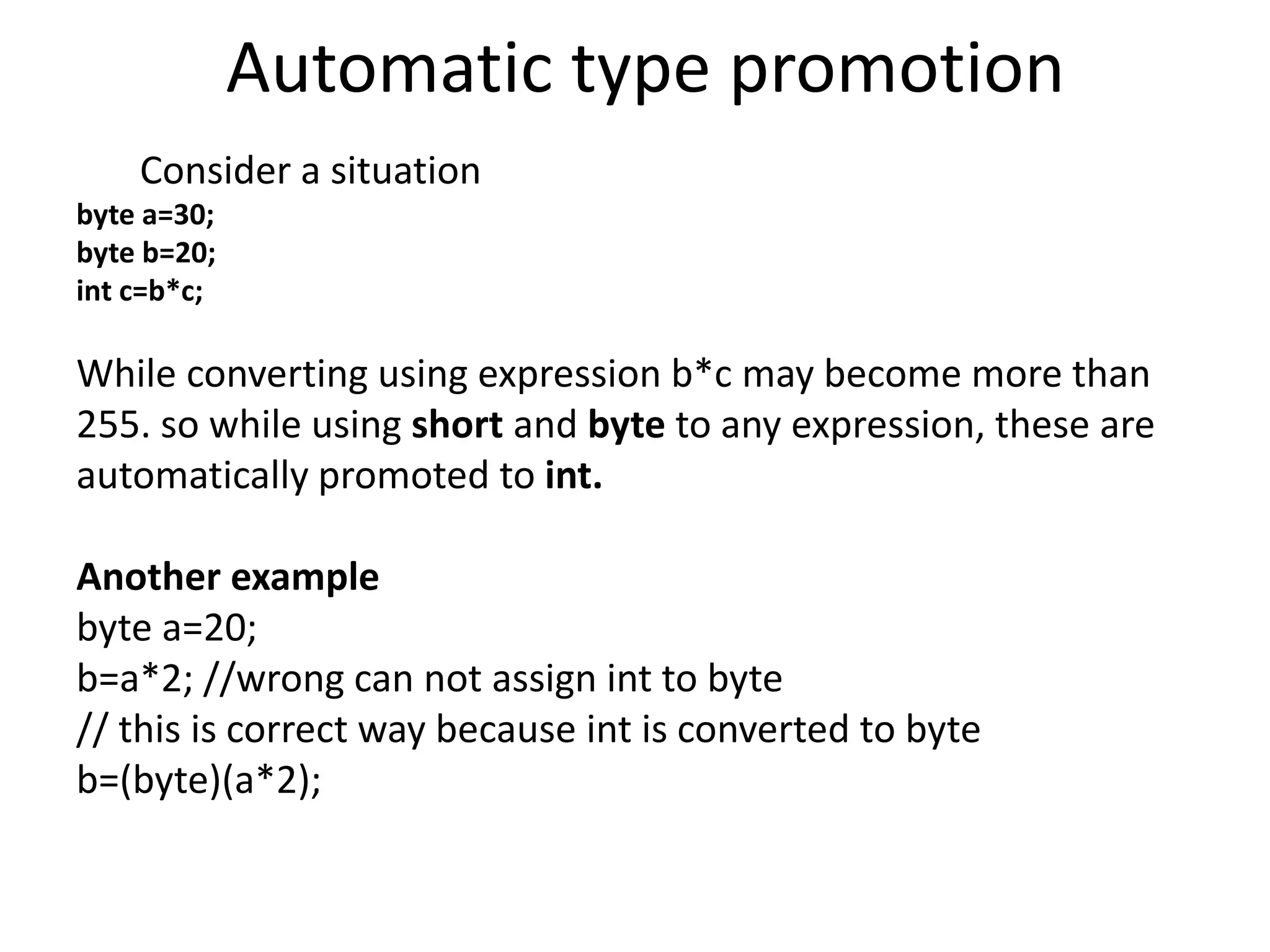
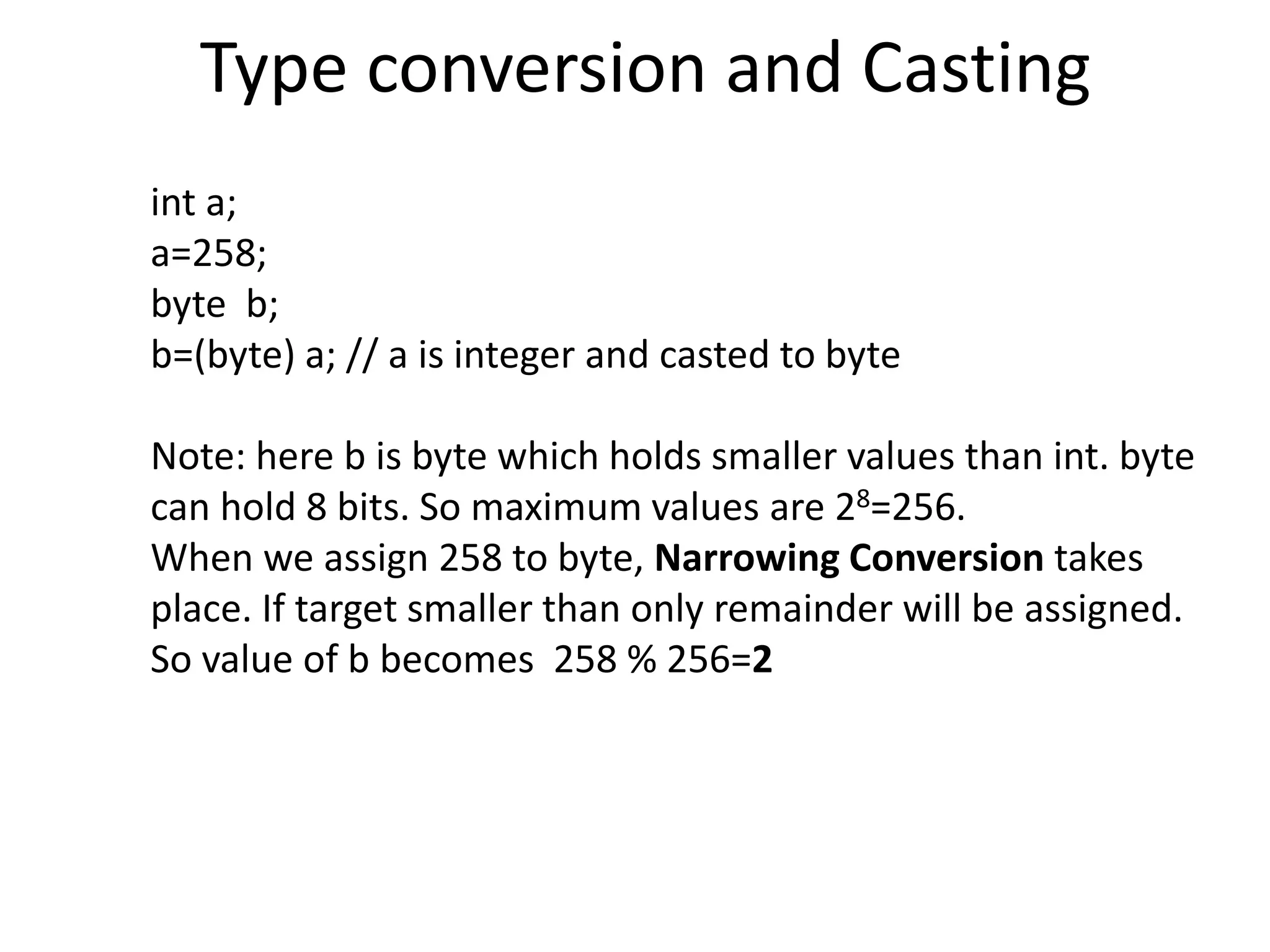
![Example public class cast { public static void main(String args[]) { int a; // this is static initialization byte b; a=258; b=(byte) a; System.out.println(b); //2 will be printed float f=15.55f; int c=(int) f; System.out.println(c); // 15 will be printed double e=1554554.4582; float g=(float) e; System.out.println(g); // 1554554.5 will be printed because it can take upto 8 digits } }](https://image.slidesharecdn.com/letest-150709131822-lva1-app6891/75/Java-Programming-concept-39-2048.jpg)
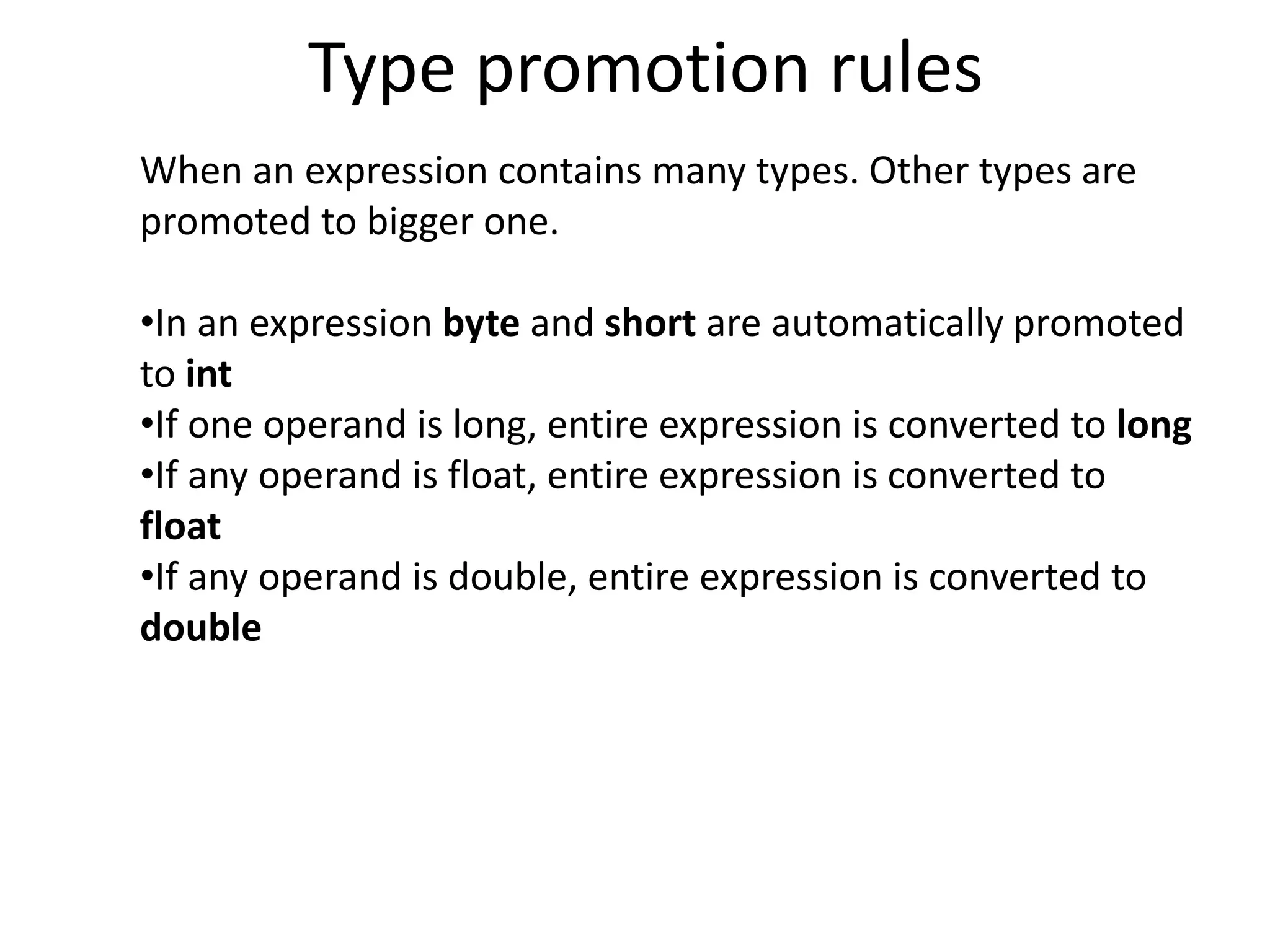
![Example of promotion class AutoPromote{ public static void main(String args[]) { byte a=50; short s=1000; int i=10550; float f=10.5f; double d=1.12546; double result=(a*s)+(i/f)+(d*i); System.out.println(result); } } Output: 62878.36471875 Here, •Expression contains largest type double, so result type must be double •a*s becomes int so a*s=50000 •In i/f, f is float so every thing becomes float so i/f=1004.7619f •In d*i, everything becomes double so d*i=11873.603](https://image.slidesharecdn.com/letest-150709131822-lva1-app6891/75/Java-Programming-concept-41-2048.jpg)
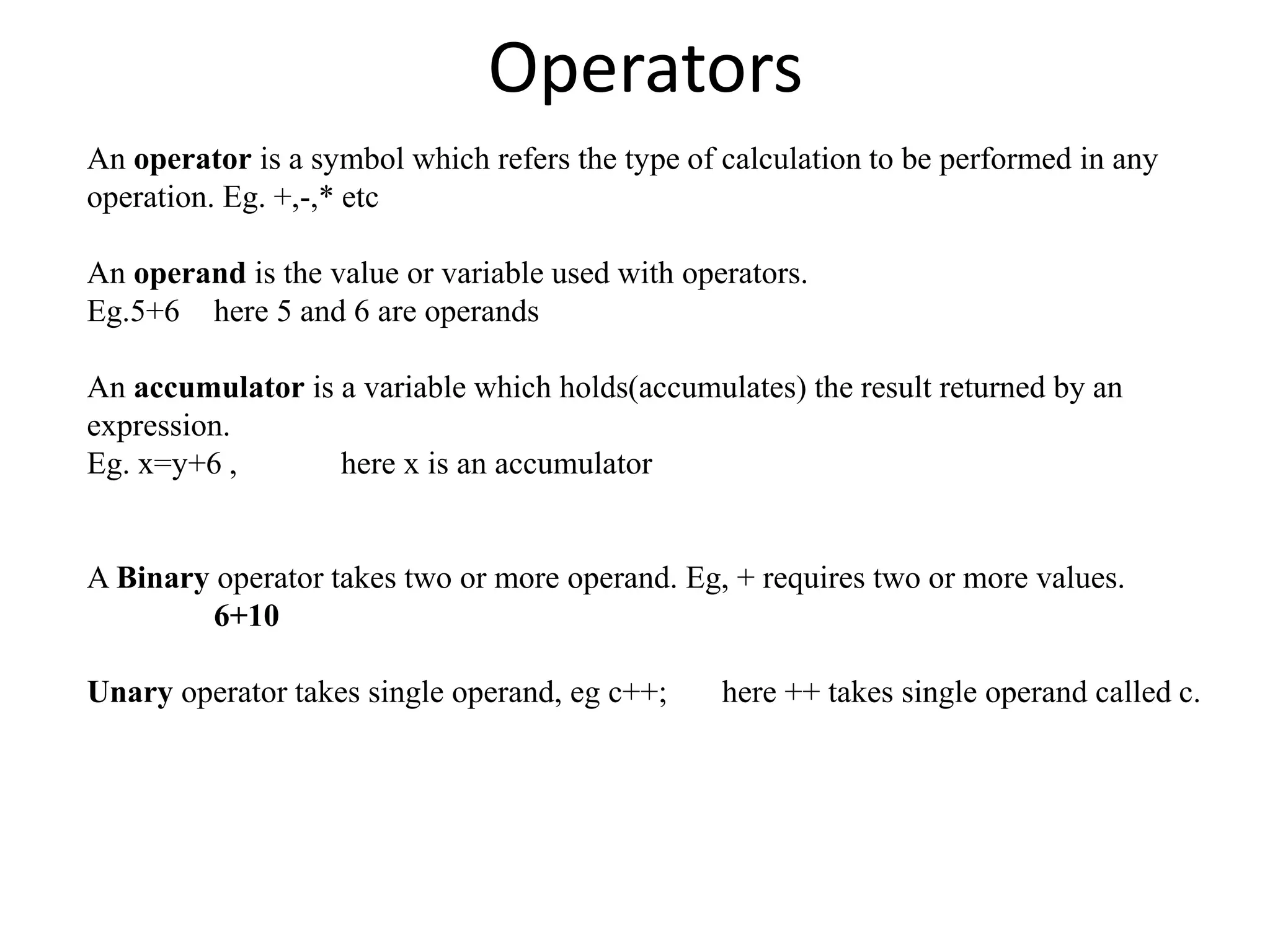
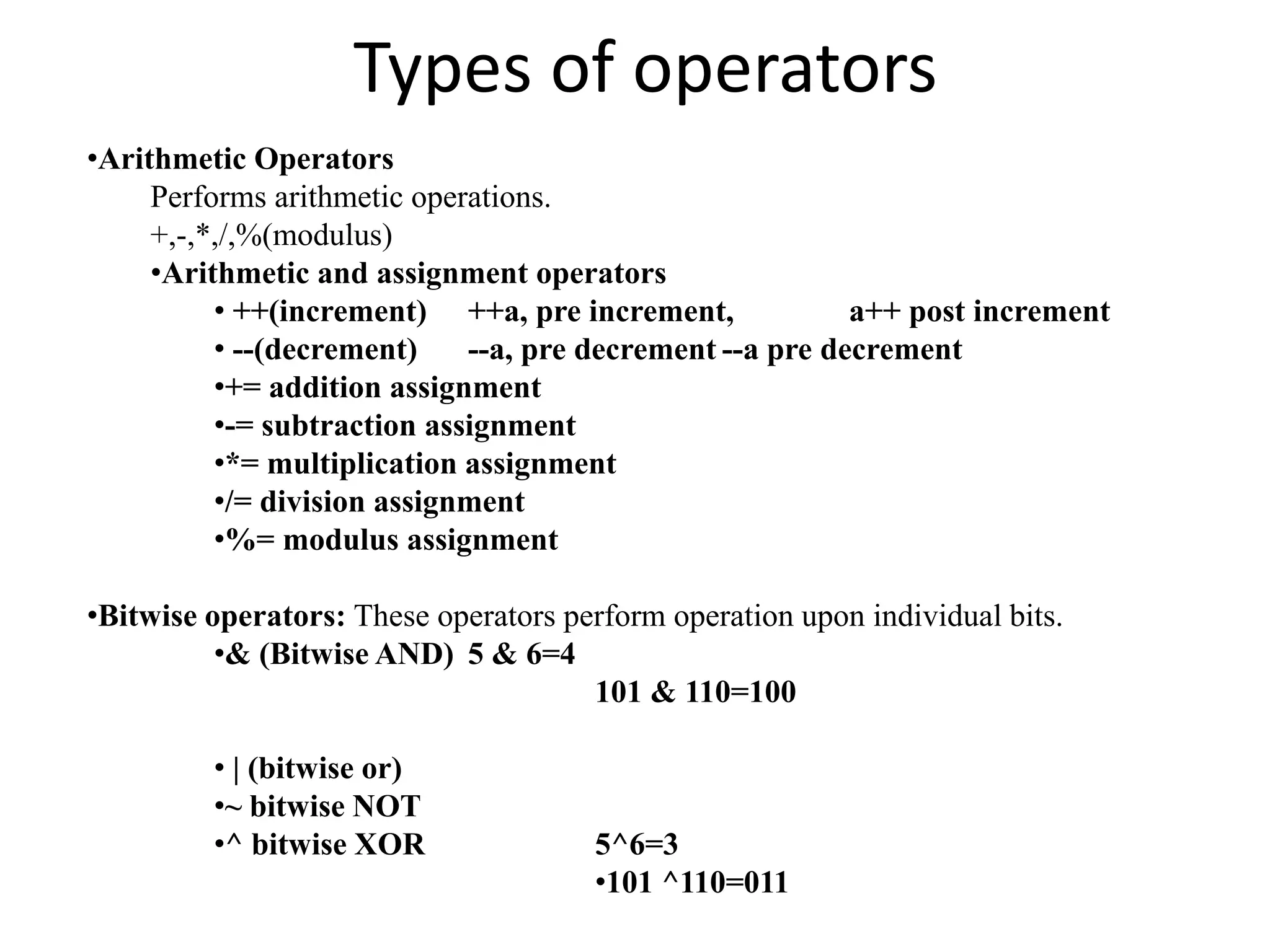
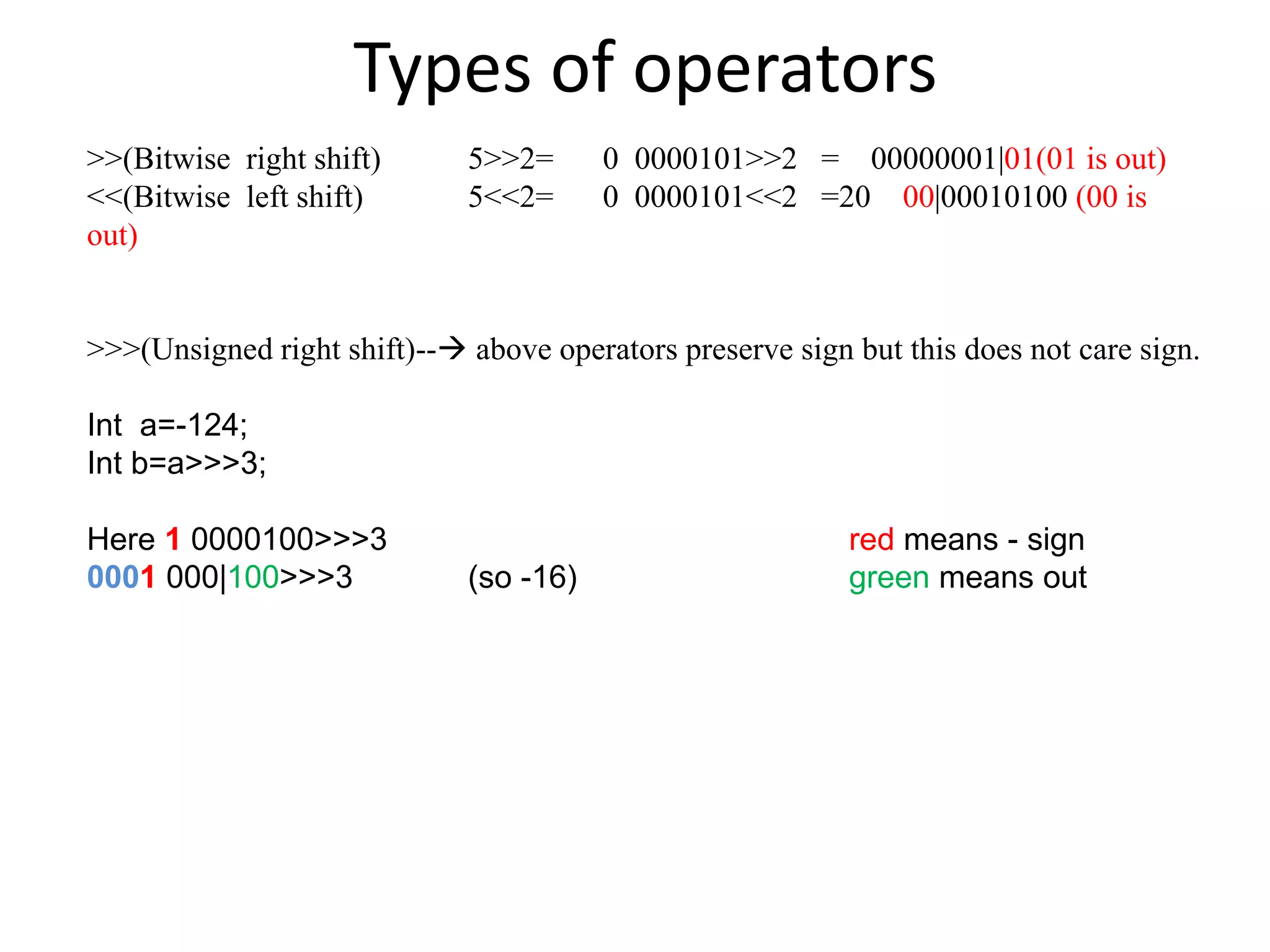
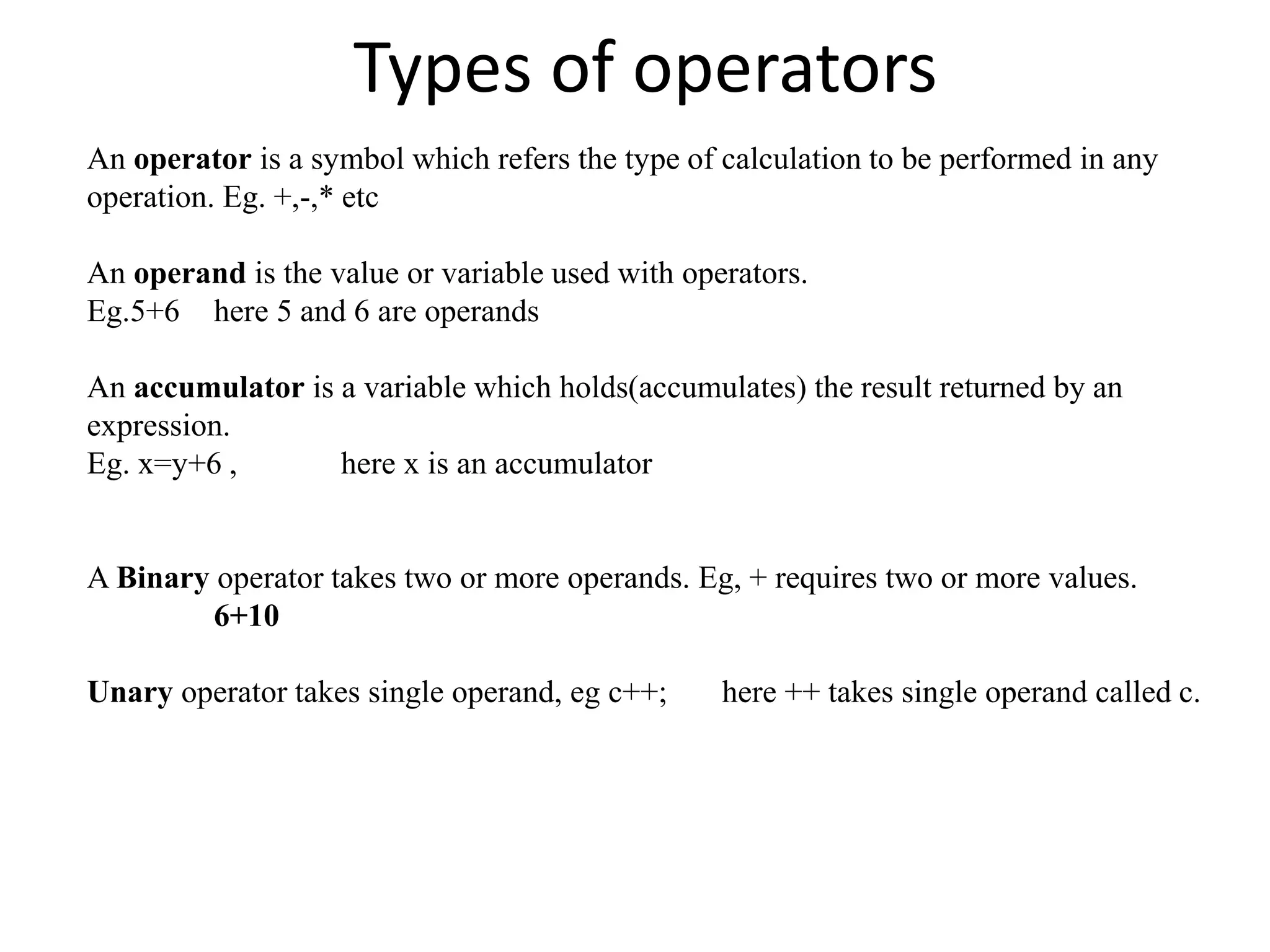
![Types of operators How bitwise operators differ from other operators ? (QB) Bitwise operators are special type of operators which perform operation for single bit. This helps to manipulate each individual bit easily. There are many bitwise operators. & (bitwise AND), ~ (Bitwise NOT), |(Bitwise OR), ^(Bitwise XOR), >> (right Shift), <<(Left Shift) etc. For example: class Test{ public static void main(String args[]) { int x=5; int y=6; int z=x & y; System.out.println(“Z is “+z); } } Here 5 means 101 6 means 110 Anding 100 means 4 This program outputs 4](https://image.slidesharecdn.com/letest-150709131822-lva1-app6891/75/Java-Programming-concept-46-2048.jpg)
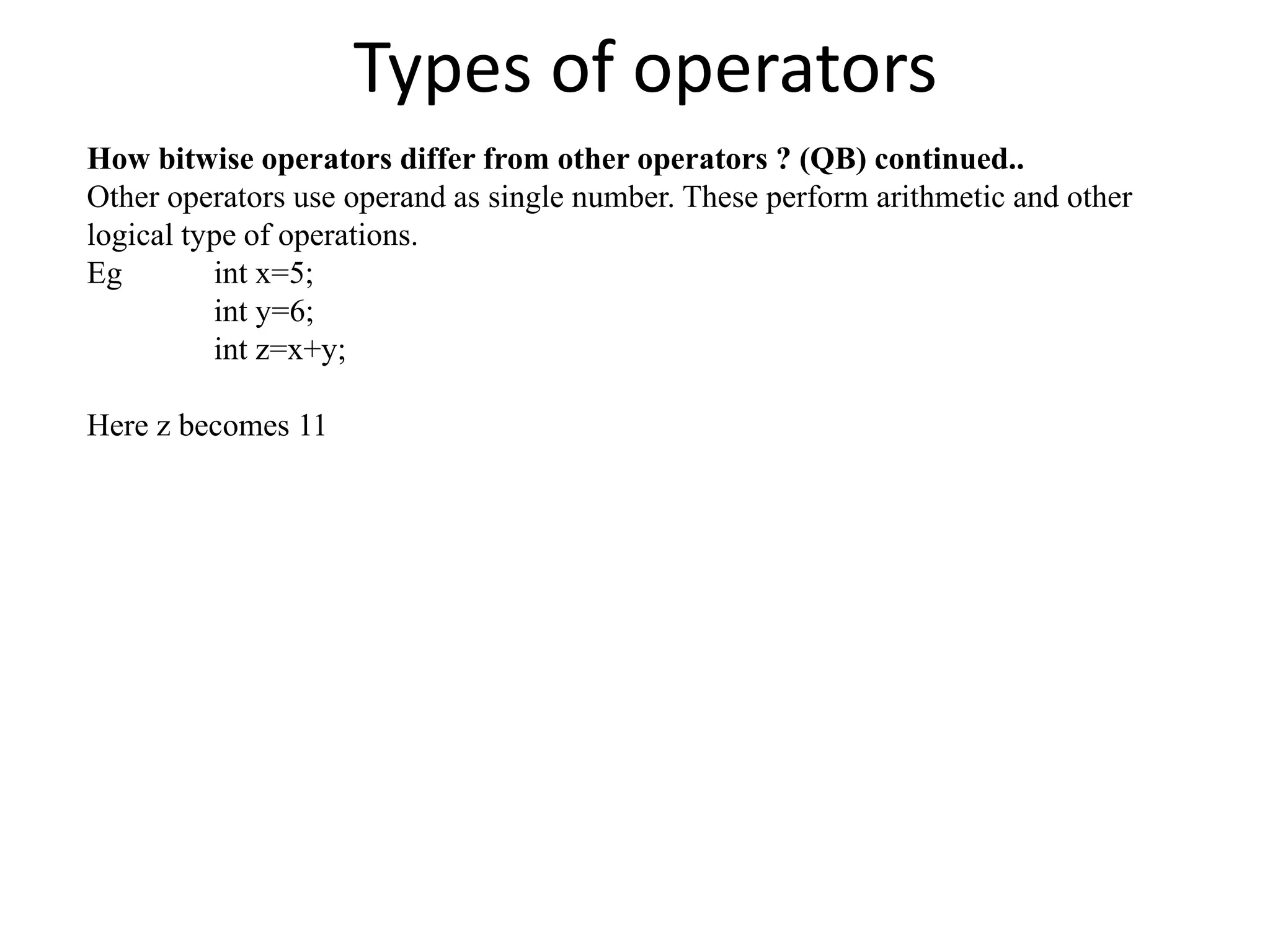
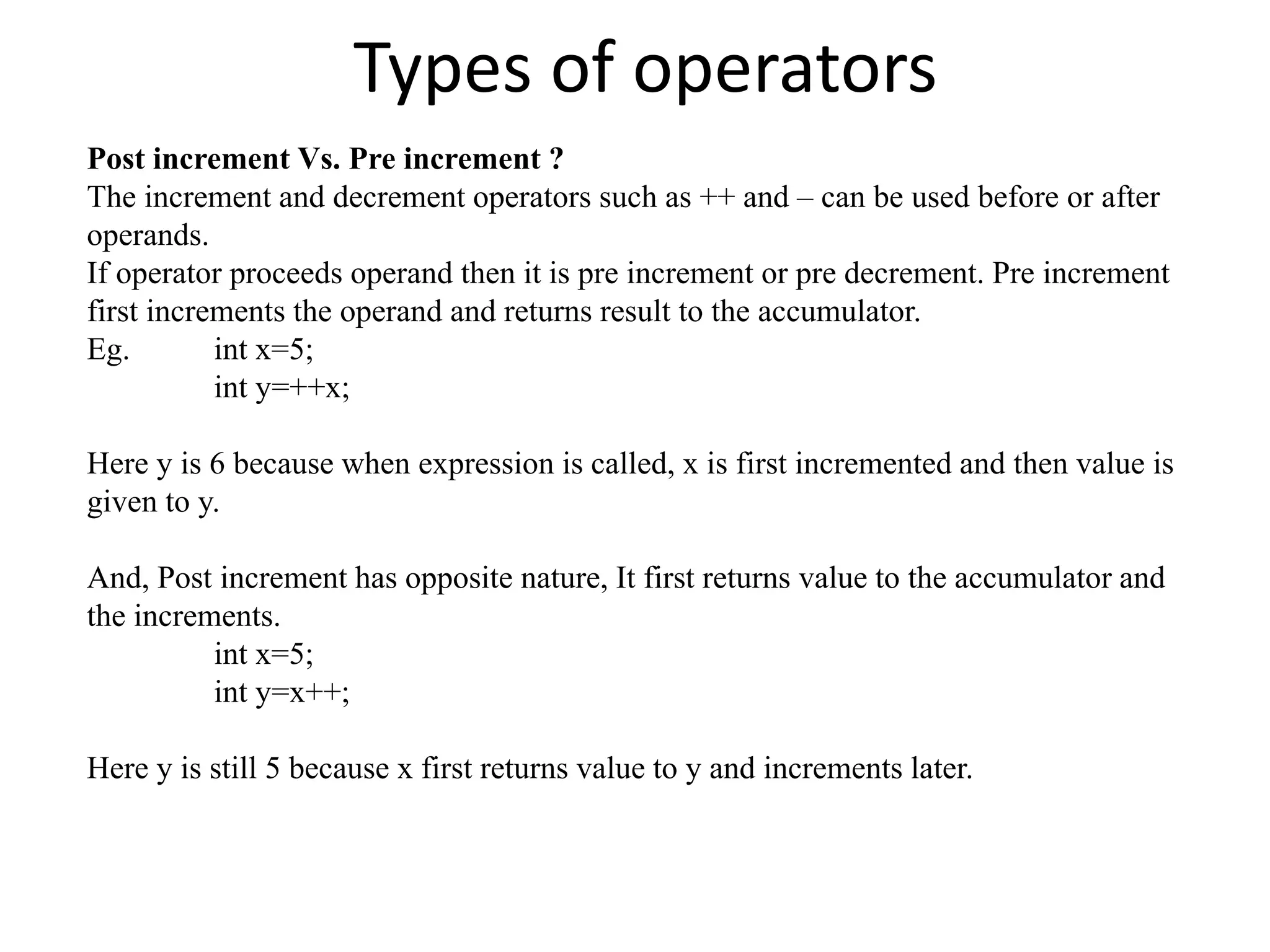
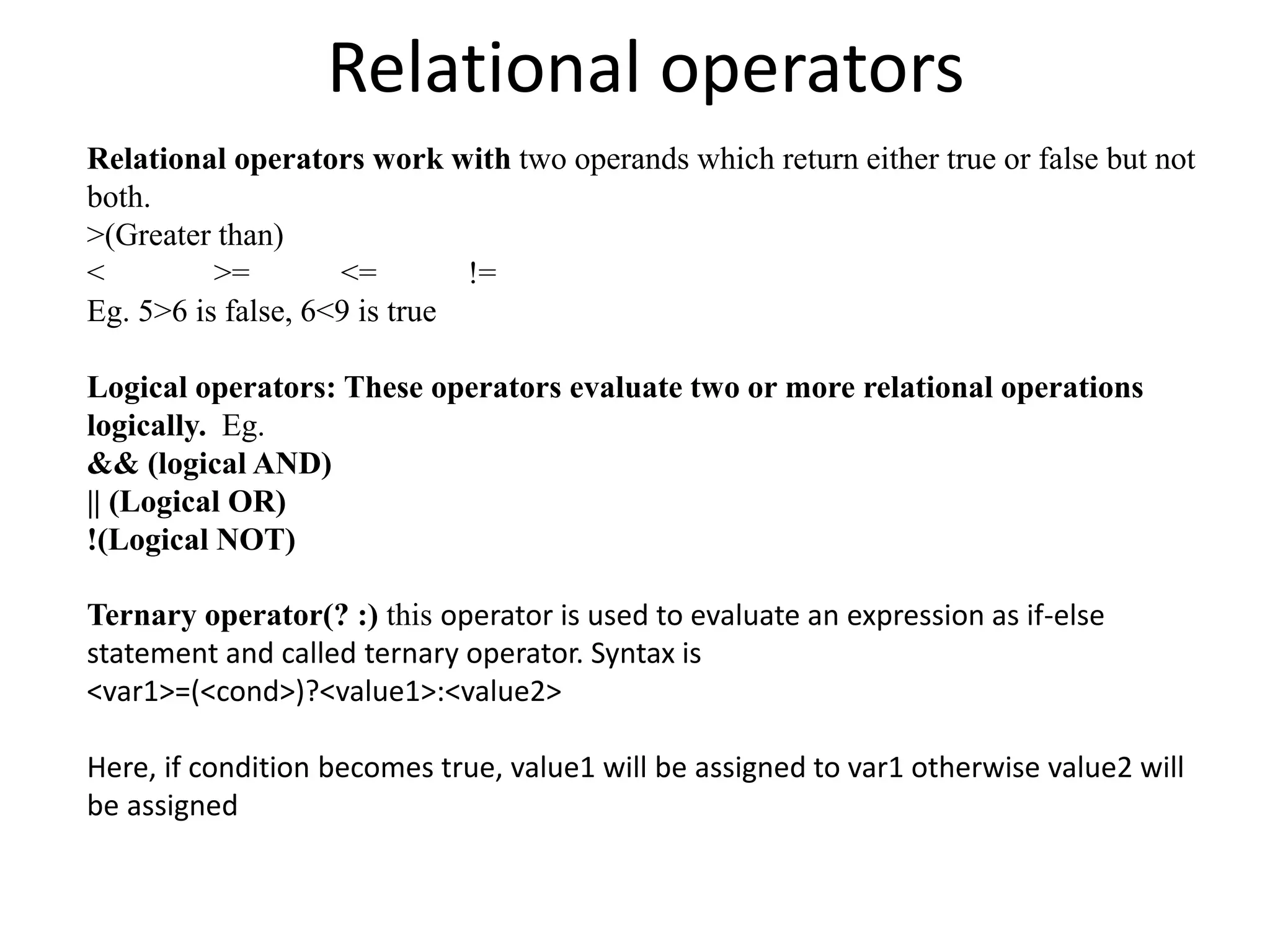
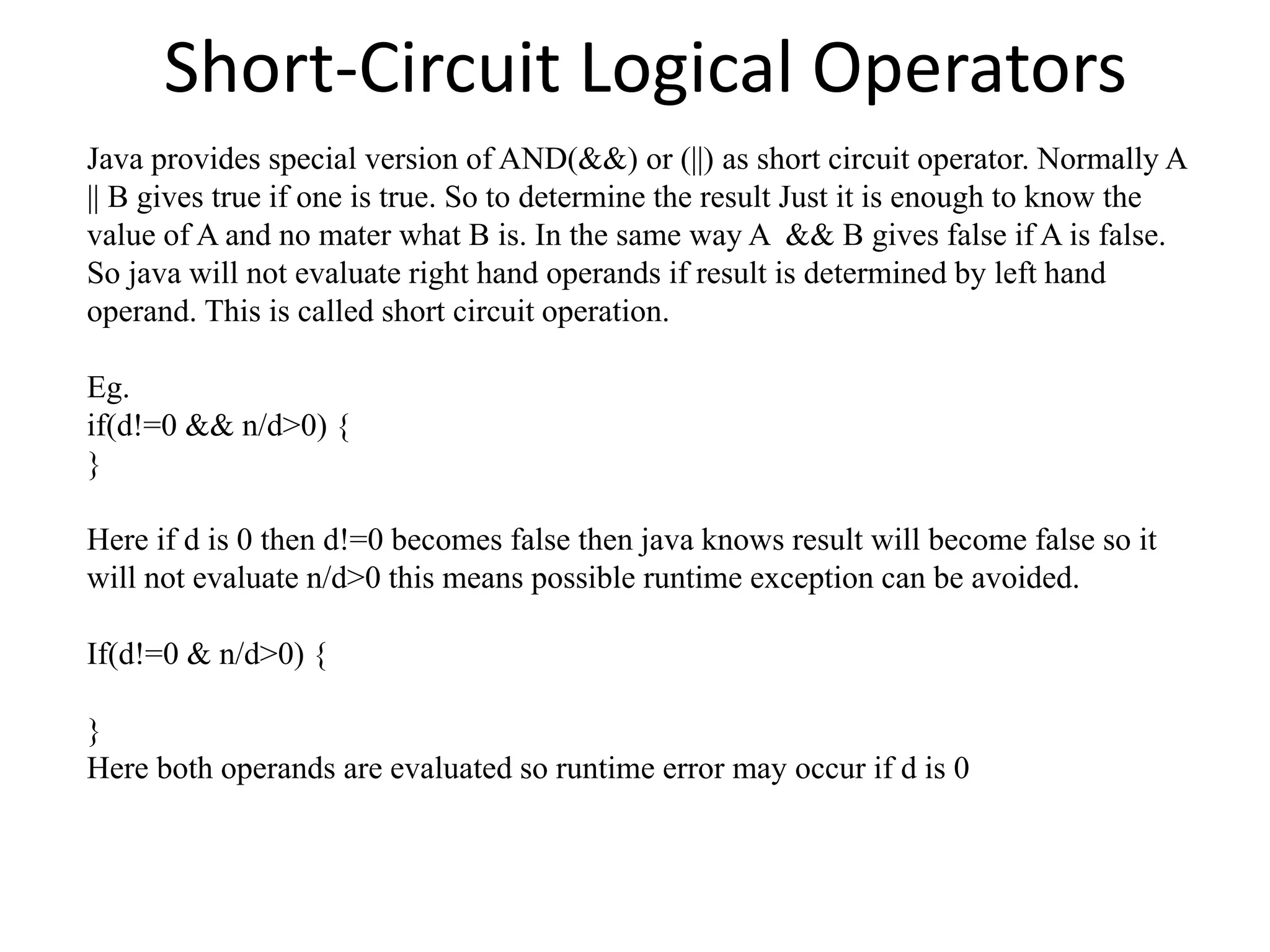
![Short-Circuit Logical Operators public class First { public static void main(String args[]) { int d=10; int n=100; if(d!=0 && n/d>5){ System.out.println(n/d); } else { System.out.println("Division not possible"); } } } public class First { public static void main(String args[]) { int d=0; int n=100; if(d!=0 && n/d>5){ System.out.println(n/d); } else { System.out.println("Division not possible"); } } } public class First { public static void main(String args[]) { int d=10; int n=100; if(d!=0 & n/d>5){ System.out.println(n/d); } else { System.out.println("Division not possible"); } } } public class First { public static void main(String args[]) { int d=0; int n=100; if(d!=0 & n/d>5){ System.out.println(n/d); } else { System.out.println("Division not possible") } } }](https://image.slidesharecdn.com/letest-150709131822-lva1-app6891/75/Java-Programming-concept-51-2048.jpg)
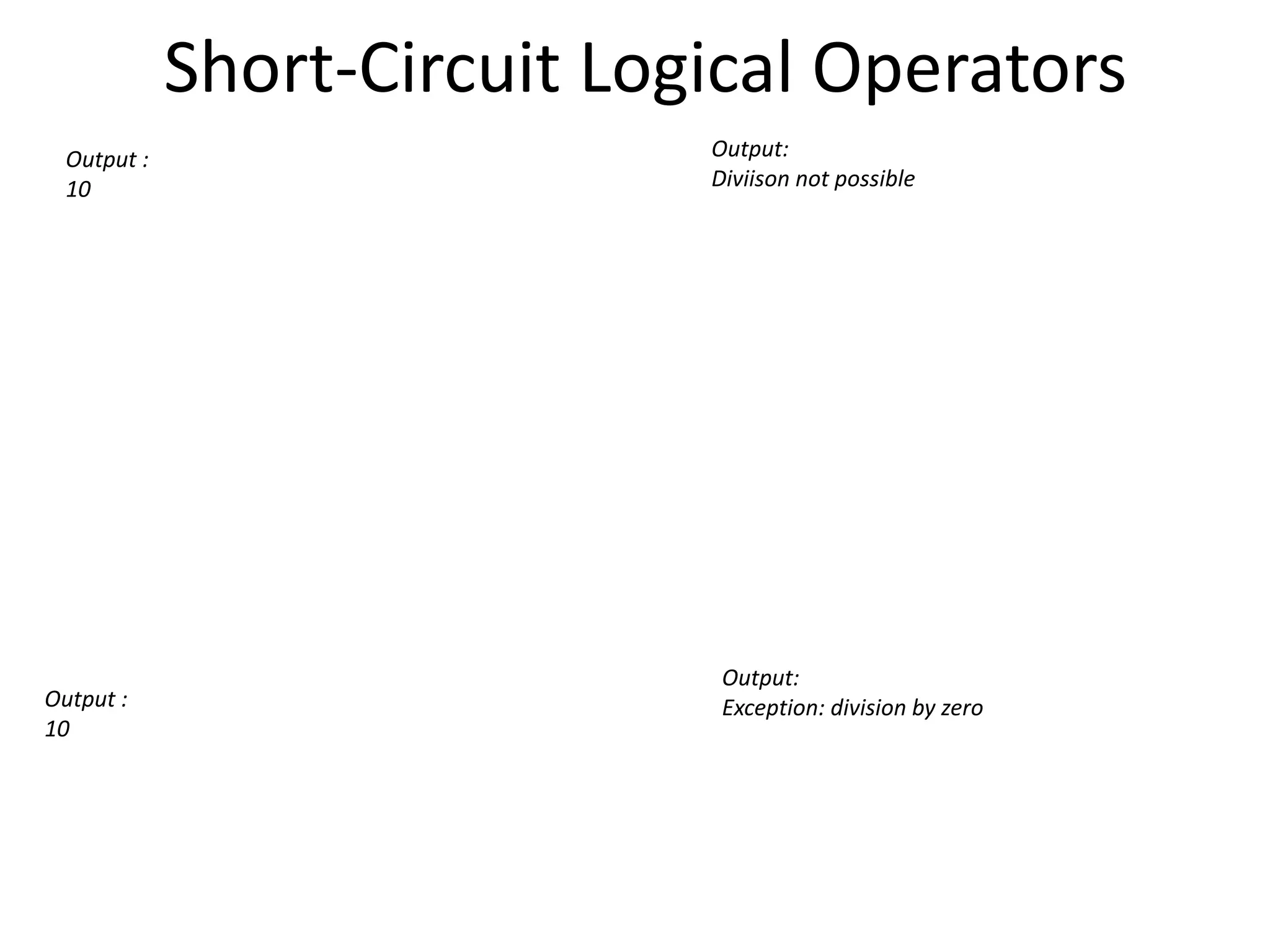
![Operator Precedence Order Order [], (),. ++,--,~,! * , /, % +, - >>, <<,>>> >, <, >=, <= ==, != & ^ | && || ?: = What is operator precedence? What is the use of? Operator. Give an example.QB Operator precedence refers the order of execution of operators in the given expression. It tells which operator is used first in an expression. ?: operator is used to evaluate an expression as if-else statement and called ternary operator. Syntax is <var1>=(<cond>)?<value1>:<value2> class Precedence{ public static void main(String args[]) { int salary=10000; int tax=(salary>5000)?salary*10/100:salary*5/100; System.out.println("Tax is "+tax); }}](https://image.slidesharecdn.com/letest-150709131822-lva1-app6891/75/Java-Programming-concept-53-2048.jpg)
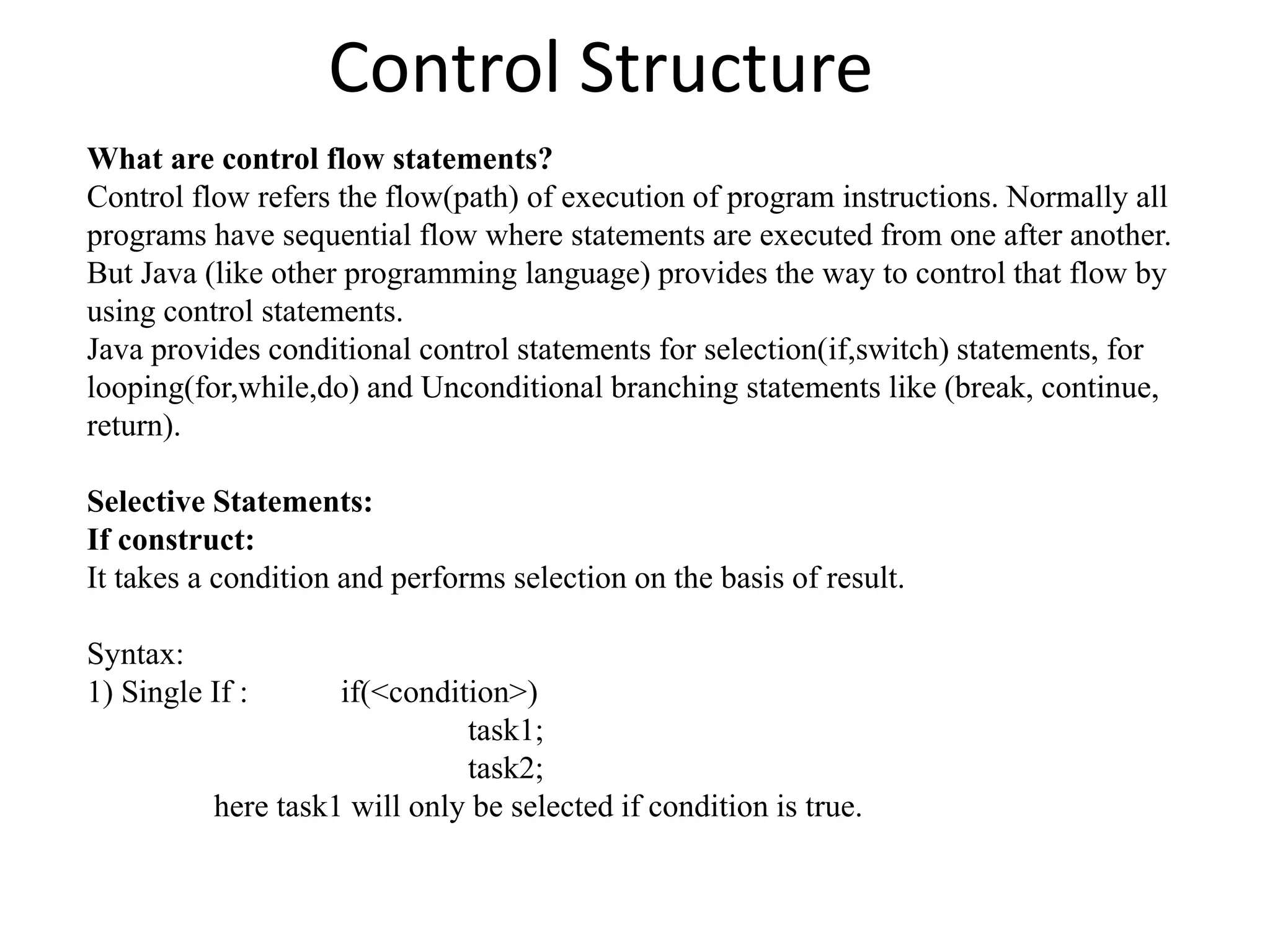
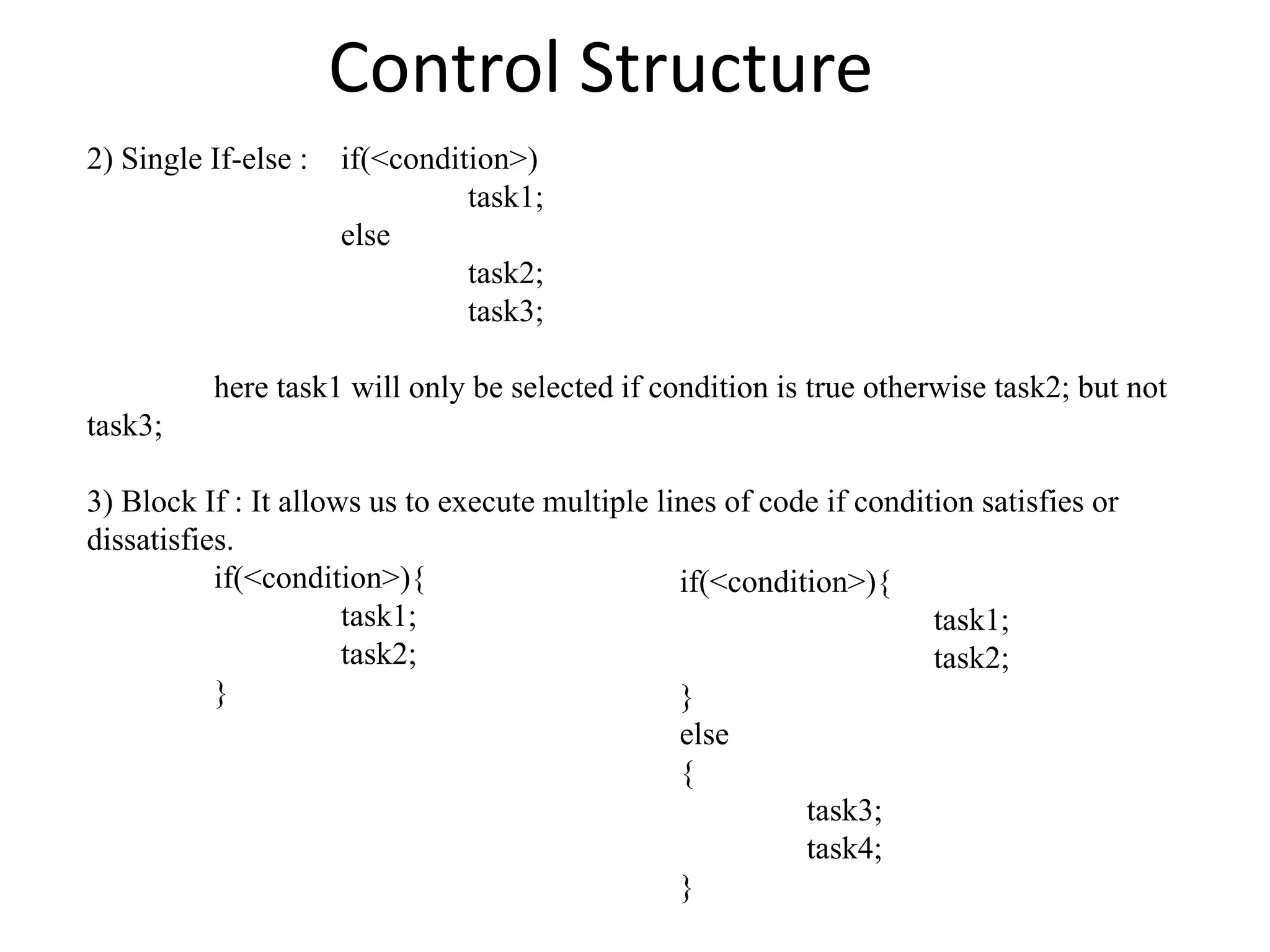
![Example: //class name is Selection so save file as Selection.java class Selection { public static void main(String args[]) { int age=10; if(age>=18) System.out.println(“You can vote”); else System.out.println(“You can not vote”); } }](https://image.slidesharecdn.com/letest-150709131822-lva1-app6891/75/Java-Programming-concept-56-2048.jpg)
![Nested if When if statement contains another if inside, this is called nested if. When else statement is used with other multiple if, it refers nearest if. class Nested{ public static void main(String args[]) { int a=5,b=6,c=7,x,y; if(a==5) { if(b<20) x=b; if(c>100)y=c; else y=b; } } } *Here else is related to nearest if, marked with red color](https://image.slidesharecdn.com/letest-150709131822-lva1-app6891/75/Java-Programming-concept-57-2048.jpg)
![public class First { public static void main(String args[]) { int m=75,s=40,e=18,c=19; int t=m+s+e+c; String div=null; float p=t/4; if(p>=80) { div="Dist"; } else { if(p>=60){ div="First"; } else { if(p>=50){ div="Second"; } else { div="Third"; } } } System.out.println("You got "+div+" Division"); } }](https://image.slidesharecdn.com/letest-150709131822-lva1-app6891/75/Java-Programming-concept-58-2048.jpg)
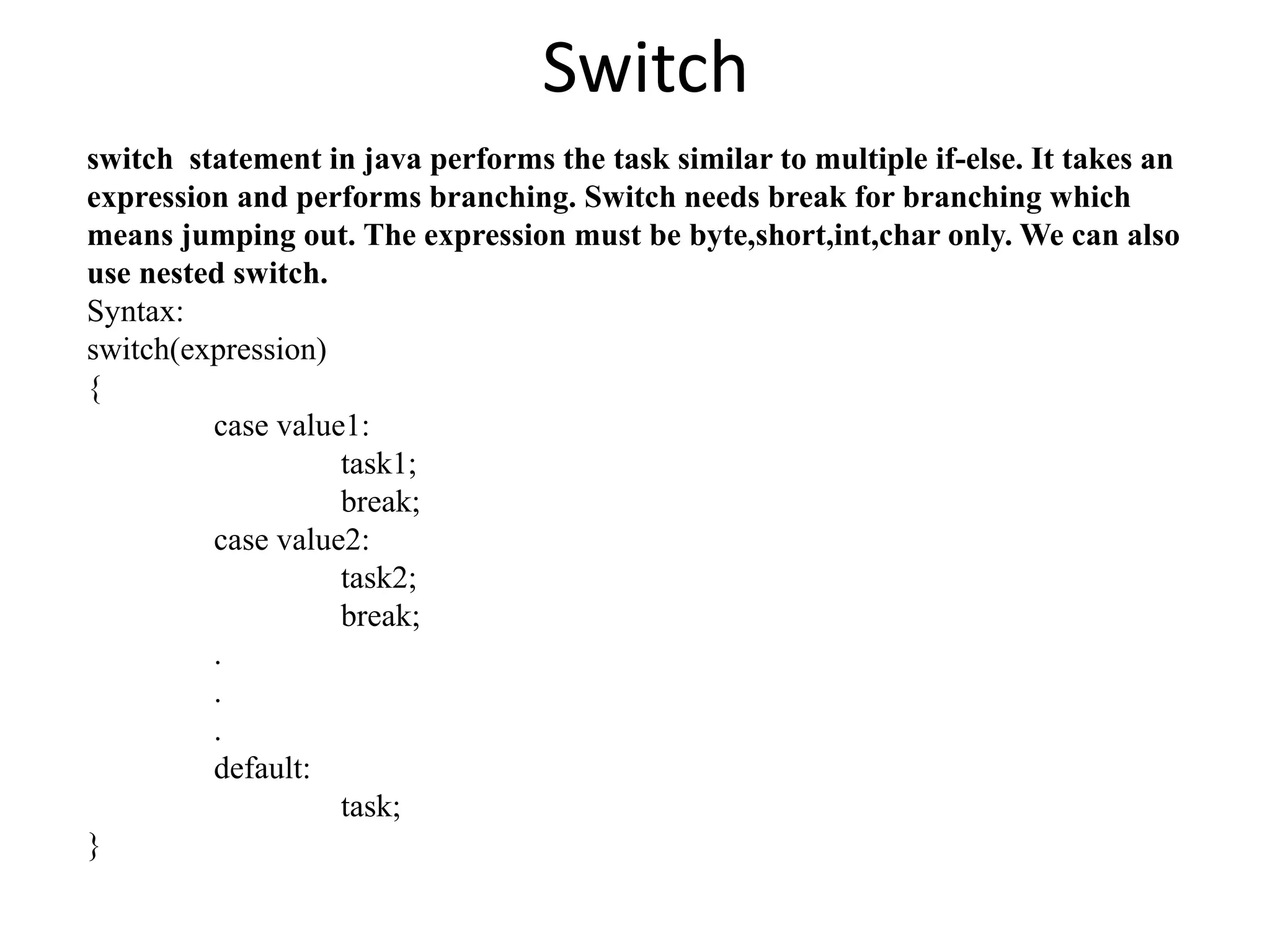
![public class First { public static void main(String args[]) throws IOException { int day=5; switch(day) { case 1: System.out.println("Sunday"); break; case 2: System.out.println("Monday"); break; case 3: System.out.println("Tuesday"); break; case 4: System.out.println("Wednesday"); break; case 5: System.out.println("Thursday"); break; case 6: System.out.println("Friday"); break; default: System.out.println("Saturday"); } } }](https://image.slidesharecdn.com/letest-150709131822-lva1-app6891/75/Java-Programming-concept-60-2048.jpg)
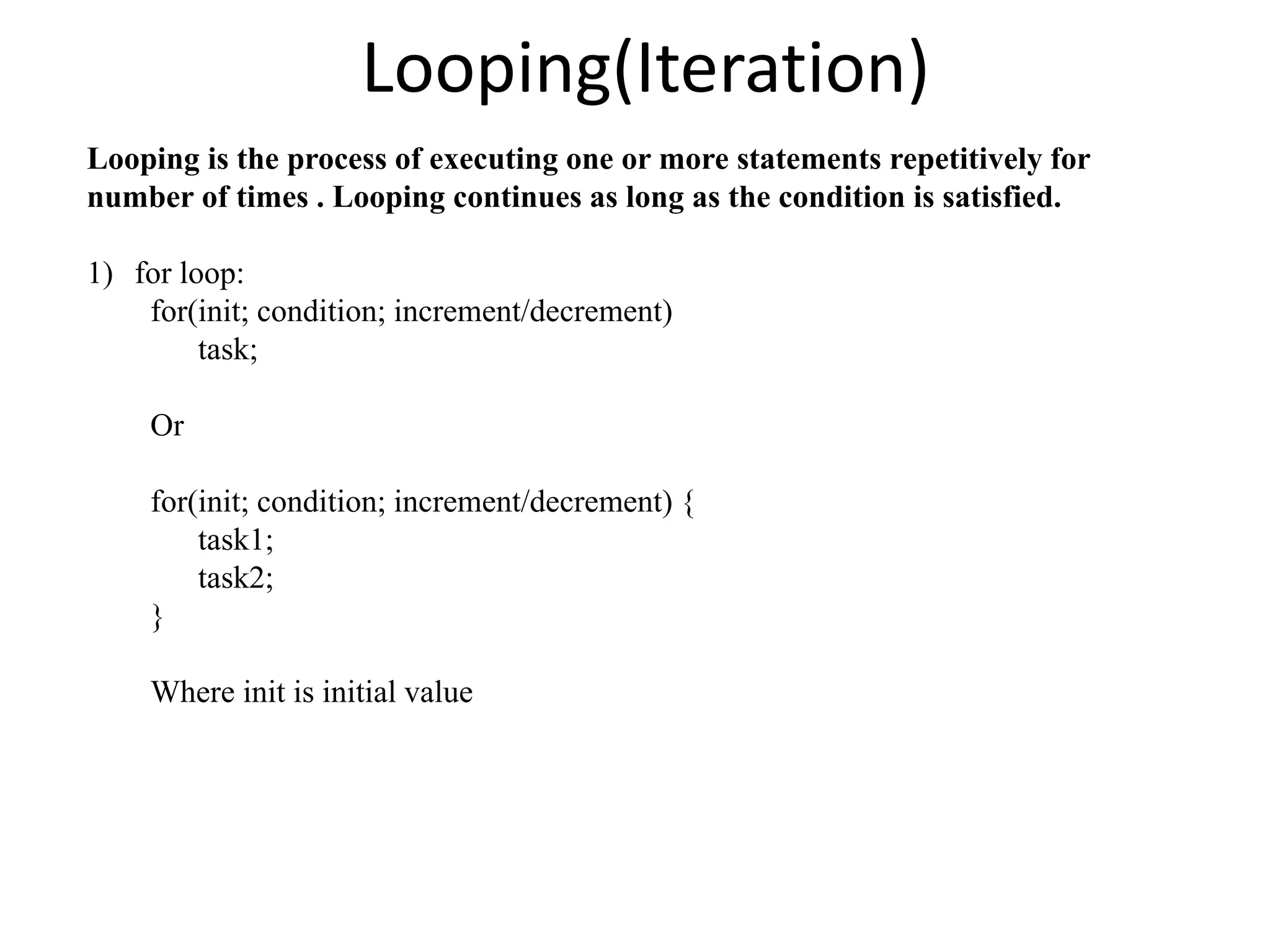
![Example Wap to print 1,11,111 upto 8th term (QB) public class First { public static void main(String args[]) throws IOException { int num=1,i; for(i=1; i<=8; i++){ System.out.println(num+"t"); num=num*10+1; } } }](https://image.slidesharecdn.com/letest-150709131822-lva1-app6891/75/Java-Programming-concept-62-2048.jpg)
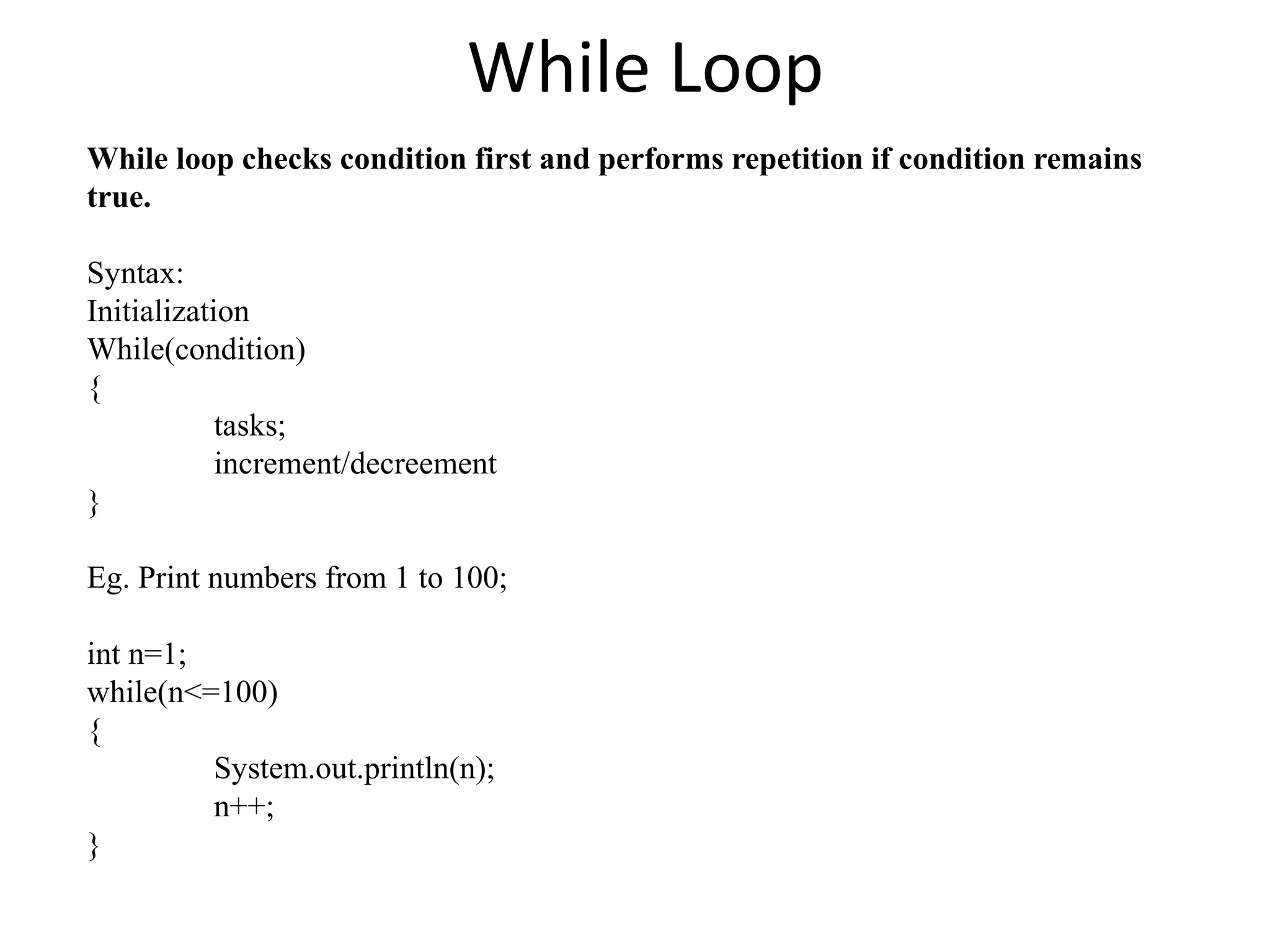
![While Loop Wap to find the sum of digits of given Number(QB) public class DigitSum{ public static void main(String args[]) { int n=123; int s=0,r; while(n>0){ r=n%10; s=s+r; n=n/10; } System.out.println(s); } }](https://image.slidesharecdn.com/letest-150709131822-lva1-app6891/75/Java-Programming-concept-64-2048.jpg)
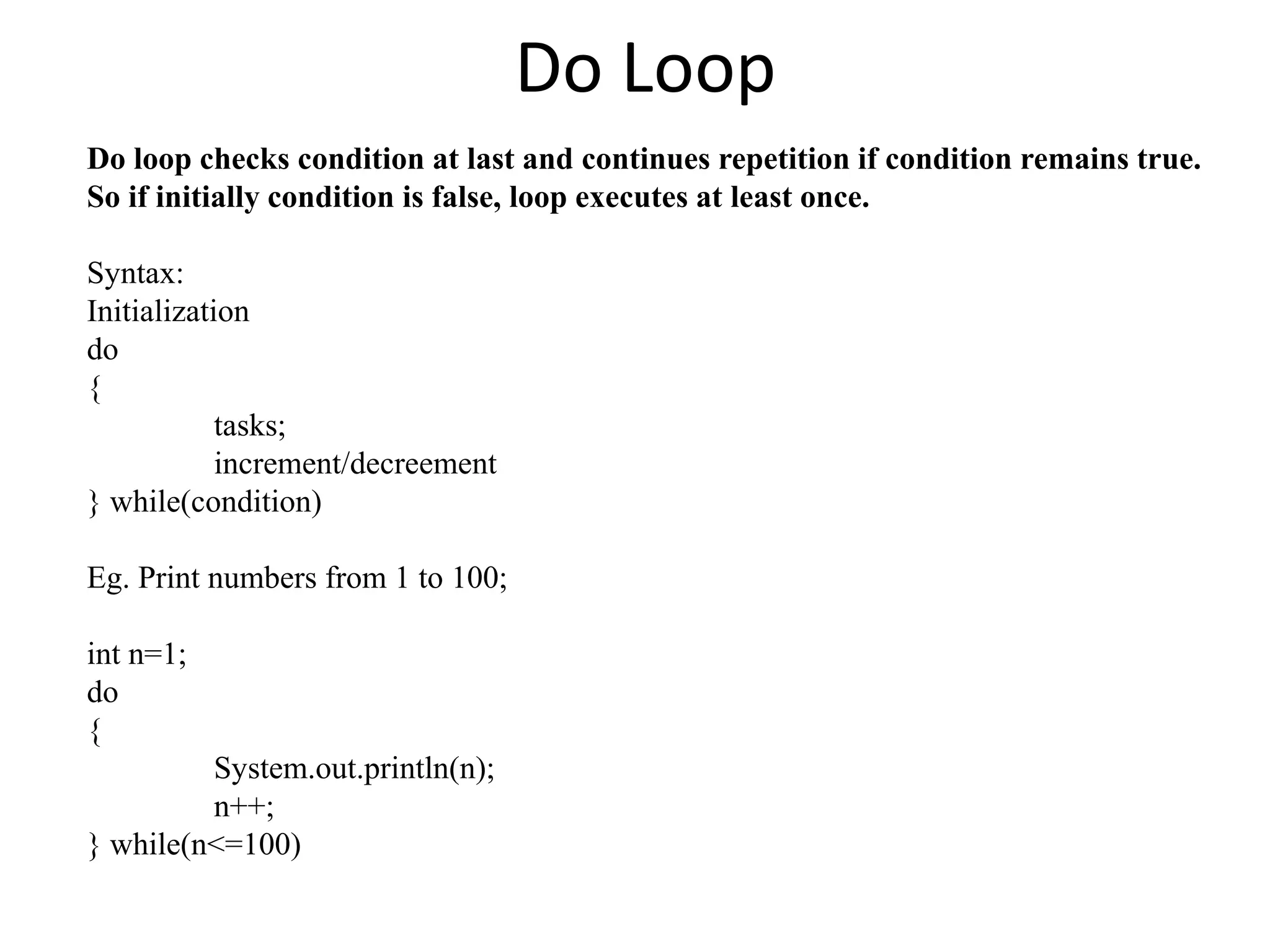
![Do Loop Wap to reverse the given digit public class DigitSum{ public static void main(String args[]) { int n=123; int s=0,r; while(n>0){ r=n%10; s=s*10+r; n=n/10; } System.out.println(s); } }](https://image.slidesharecdn.com/letest-150709131822-lva1-app6891/75/Java-Programming-concept-66-2048.jpg)
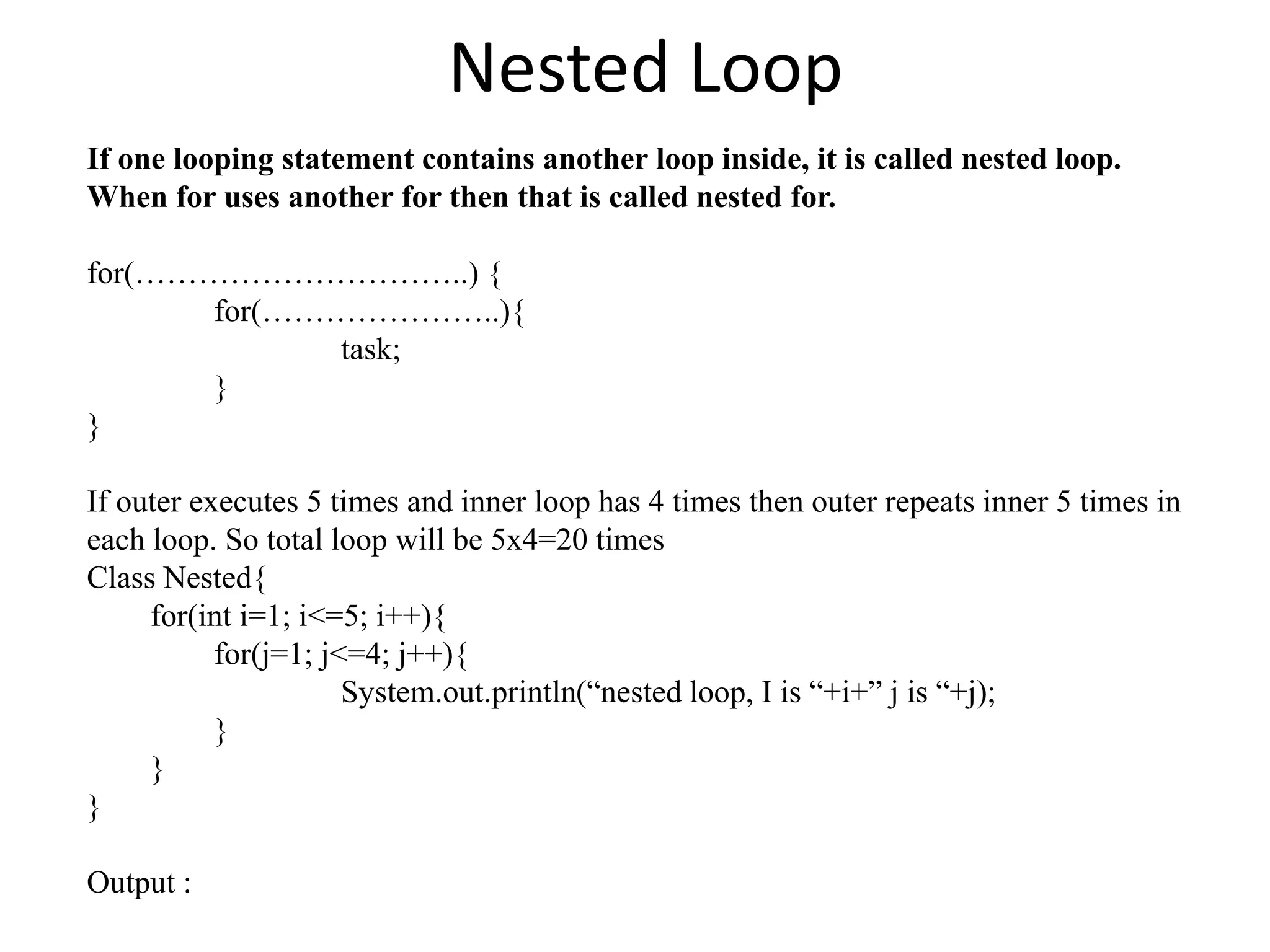
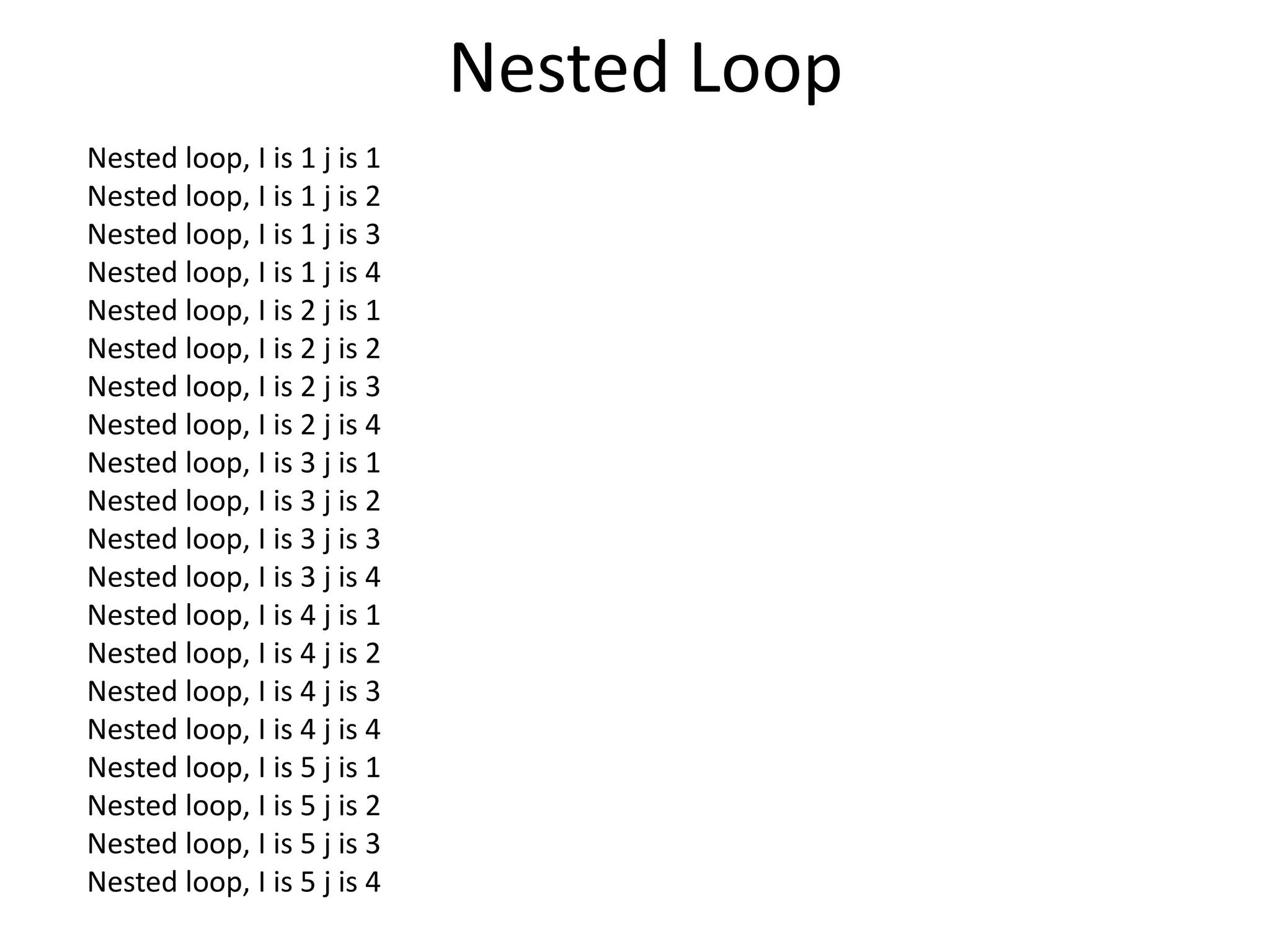
![Using comma with for Rewrite the program to reverse number public class First { public static void main(String args[]) { int n,s; int r; for(n=123,s=0; n>0; n=n/10){ r=n%10; s=s*10+r; } System.out.println(s); } } Output: 321](https://image.slidesharecdn.com/letest-150709131822-lva1-app6891/75/Java-Programming-concept-69-2048.jpg)
![Jump Statements Java provides following jump statements: 1) break: this statement is used to exit from a loop. break statement can also be used to exit from certain block. Syntax: break; Or break block_name; class First { public static void main(String args[]) { for(int i=1; i<=100; i++){ System.out.print (i+” “); if(i==5) break; } } } 1 2 3 4 5](https://image.slidesharecdn.com/letest-150709131822-lva1-app6891/75/Java-Programming-concept-70-2048.jpg)
![Jump Statements Java provides following jump statements: 2) continue: This statement forces to skip remaining code in the loop and continue to early part of loop. continue; class First { public static void main(String args[]) { for(int i=1; i<=10; i++){ if(i==5) continue; // 5 will not be printed because next code will be skipped System.out.print (i+” “); } } } 1 2 3 4 6 7 8 9 10](https://image.slidesharecdn.com/letest-150709131822-lva1-app6891/75/Java-Programming-concept-71-2048.jpg)
![Jump Statements Java provides following jump statements: 3) return: This statement is used to return from function body. This causes remaining code ina function to be skipped. class First { public static void main(String args[]) { System.out.print ("Hello"); if(true) return; System.out.print ("Hi"); } } Output: Hello](https://image.slidesharecdn.com/letest-150709131822-lva1-app6891/75/Java-Programming-concept-72-2048.jpg)
![Arrays An array is a group of variables which are referred by common name. An array can hold multiple values of similar type which can be accessed by using index. • One dimensional Array: This type of array holds single row of data. Declaring an array: Syntax: type var_name[] Eg. int nums[]; Allocating Memory: var_name=new type[size]; eg;. nums=new int[10]; Direct method: int nums[]=new int[10]; Alternate Direct method: int[] nums=new int[10];](https://image.slidesharecdn.com/letest-150709131822-lva1-app6891/75/Java-Programming-concept-73-2048.jpg)
![Arrays Assigning values: nums[0]=15; nums[1]=20; nums[2]=24’ Etc. Direct assignment: int[] odds={1,3,5,7}; Or int odds[]={1,3,5,7}; Accessing value: System.out.println(odds[0]); ---------- prints 1](https://image.slidesharecdn.com/letest-150709131822-lva1-app6891/75/Java-Programming-concept-74-2048.jpg)
![Arrays Example: class First { public static void main(String args[]) { int[] odds={1,3,5,7,9}; int i; for(i=0; i<odds.length;i++){ System.out.println(odds[i]); } } } Multidimensional Array: Multidimensional Array holds values in tabular format. It is actually an array of arrays. To declare multidimensional array, we need to use multiple sets of brackets. [] Example: int a[][]=new int[2][3]; Or int[][] a=new int[2][3];](https://image.slidesharecdn.com/letest-150709131822-lva1-app6891/75/Java-Programming-concept-75-2048.jpg)
![Arrays Assigning values in multi-dimensional array. int a[][]={ {1,3,5}, {4,8,9} }; Here a[0][0] is 1 a[0][1] is 3 a[0][2] is 5 a[1][0] is 4 a[1][1] is 8 a[1][2] is 9](https://image.slidesharecdn.com/letest-150709131822-lva1-app6891/75/Java-Programming-concept-76-2048.jpg)
![Arrays Example: class First { public static void main(String args[]) { int i,j; int n[][]={ {1,8,7}, {2,5,9} }; for(i=0; i<2; i++) { for(j=0; j<3; j++) { System.out.println(n[i][j]); } } } }](https://image.slidesharecdn.com/letest-150709131822-lva1-app6891/75/Java-Programming-concept-77-2048.jpg)
![Variable size array Variable size array is a type of multi-dimensional array where number of array elements are not equal. Wap to print following array (QB) Int[][] a={{1,2,3},{4,5},{6,7,8,9,10,11},{12},{13,14}}; class First { public static void main(String args[]) { int[][] a={{1,2,3},{4,5},{6,7,8,9,10,11},{12},{13,14}}; int i; for(i=0; i<4;i++){ for(int j=0; j<odds[i].length; j++){ System.out.print(odds[i][j]); } System.out.print("n"); } } }](https://image.slidesharecdn.com/letest-150709131822-lva1-app6891/75/Java-Programming-concept-78-2048.jpg)
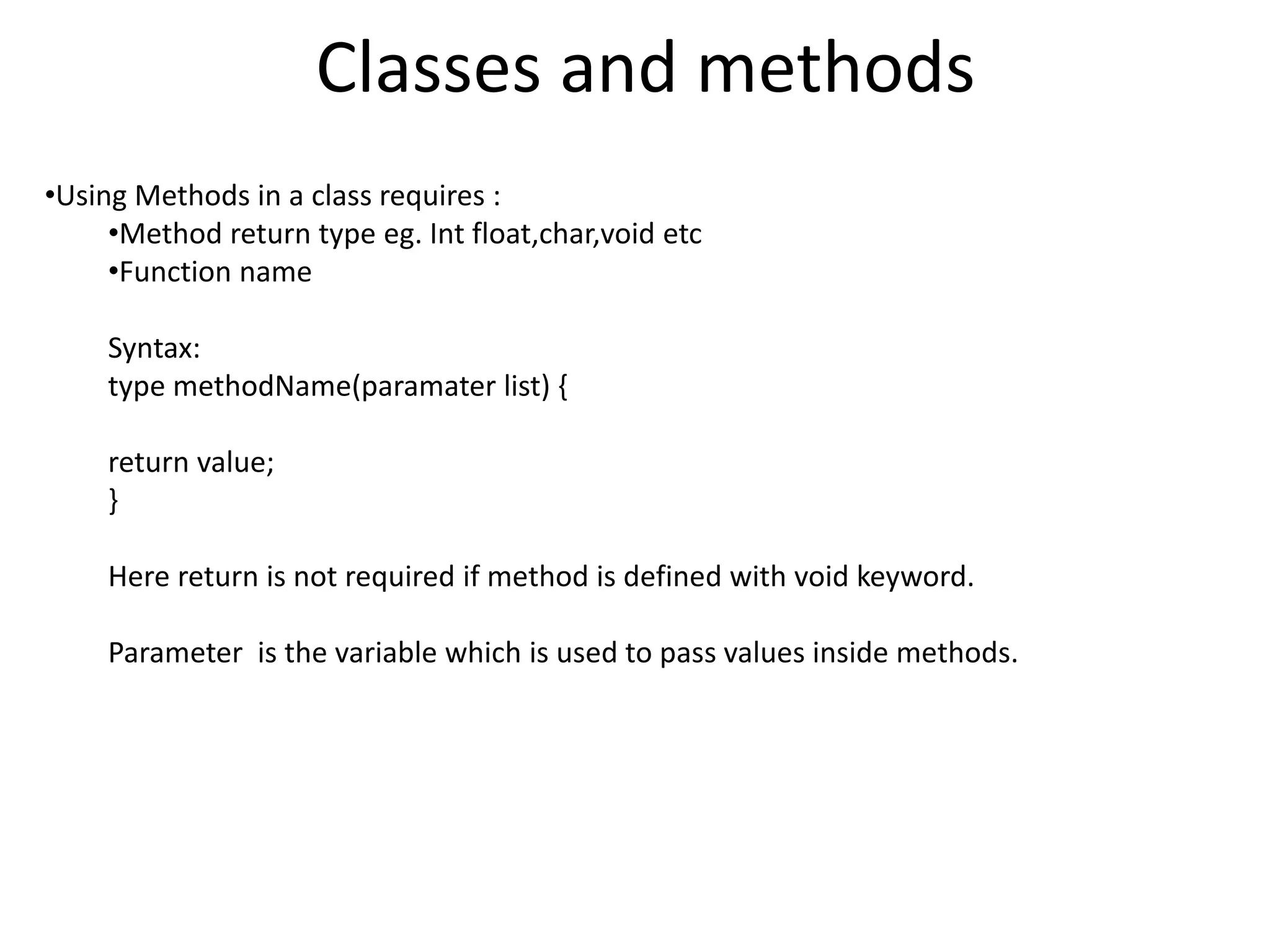
![Classes and methods class First { public static void main(String args[]) { First obj=new First(); obj.greetings(); int result=obj.sum(55,50); System.out.println("Sum is "+result); } void greetings(){ System.out.println("Hi, Good Morning n"); } int sum(int a, int b){ return a+b; } } Output: Hi, Good Morning Sum is 105](https://image.slidesharecdn.com/letest-150709131822-lva1-app6891/75/Java-Programming-concept-80-2048.jpg)
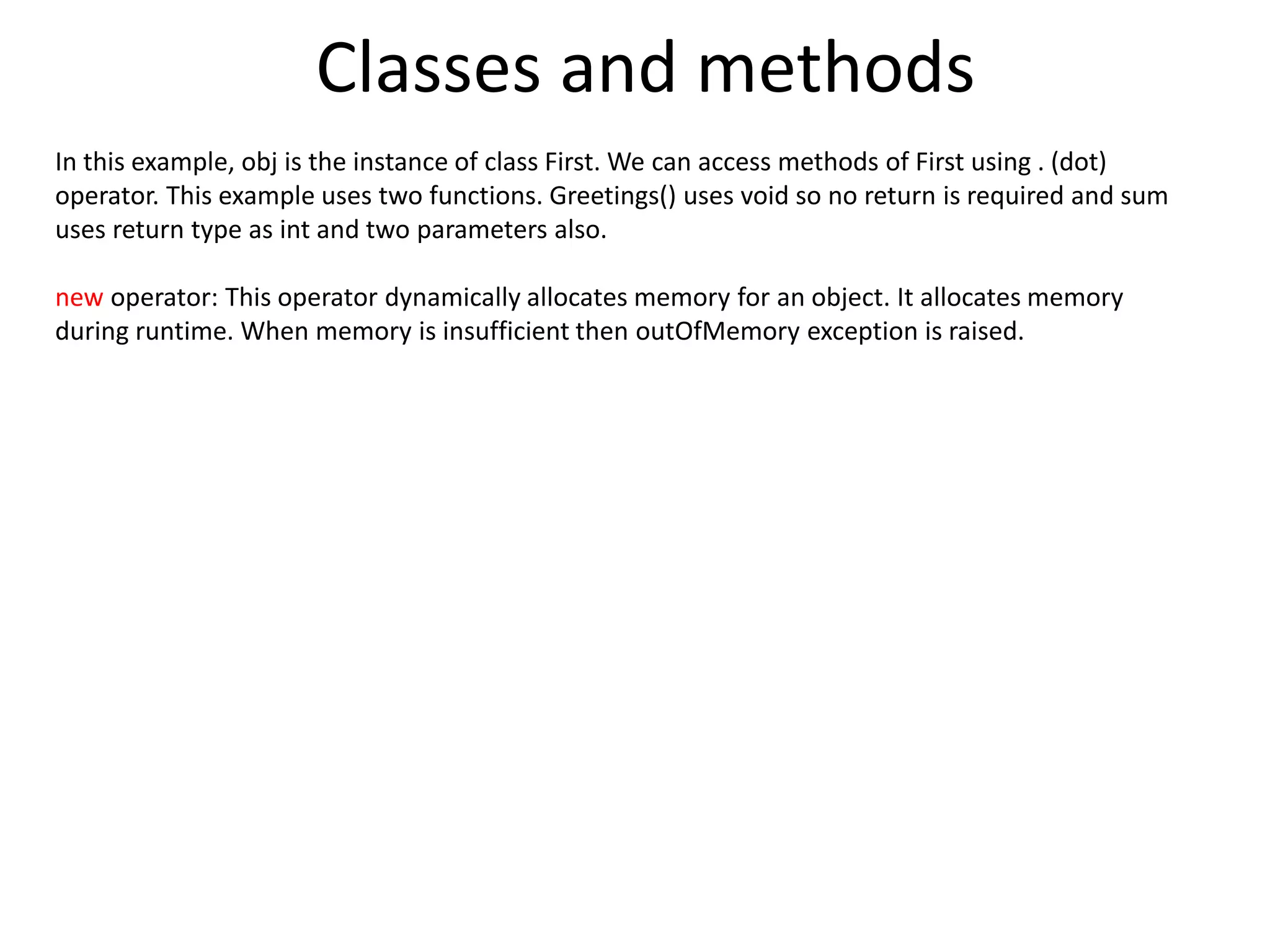
![Classes and methods class MyRectangle{ int l; int b; void area(){ int a=l*b; System.out.println("Area is "+a); } } class First { public static void main(String args[]) { MyRectangle big,small; //declare reference object big=new MyRectangle(); // allocate memory to big object big.l=20; big.b=15; big.area(); small=new MyRectangle(); small.l=5; small.b=3; small.area(); } } Area is 300 Area is 15](https://image.slidesharecdn.com/letest-150709131822-lva1-app6891/75/Java-Programming-concept-82-2048.jpg)
![Constructor Constructor is similar to method but it is called automatically when object of the class is created. A constructor has similar name to class. It is used to initialize the values upon creation of object. A constructor can take parameters also. Consructor can also be overloaded. class MyRectangle{ MyRectangle(){ System.out.println("Object created"); } } class First { public static void main(String args[]) { MyRectangle a; a=new MyRectangle(); // here constructor is called } } Output: Object Created](https://image.slidesharecdn.com/letest-150709131822-lva1-app6891/75/Java-Programming-concept-83-2048.jpg)
![Parameterized Constructor class MyRectangle{ int length,breadth; MyRectangle(int l,int b){ length=l; breadth=b; } int area(){ return length*breadth; } int perimeter(){ return 2*(length+breadth); } } class First { public static void main(String args[]) { MyRectangle a; a=new MyRectangle(5,10); // here constructor is called System.out.println("Area is "+a.area()); System.out.println("Perimeter is "+a.perimeter()); } } Area is 50 Perimeter is 30](https://image.slidesharecdn.com/letest-150709131822-lva1-app6891/75/Java-Programming-concept-84-2048.jpg)